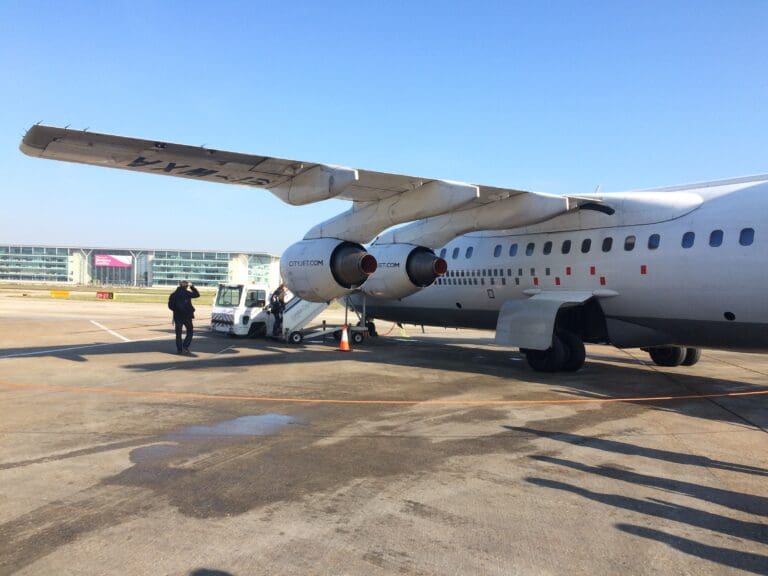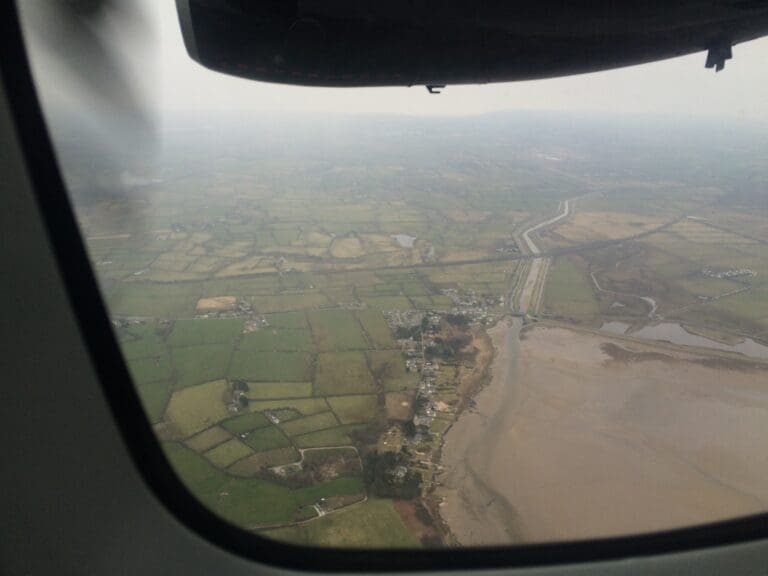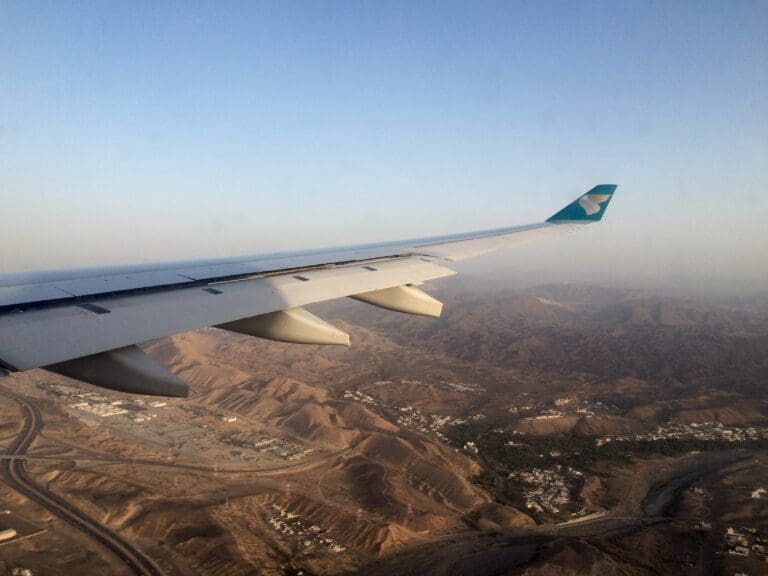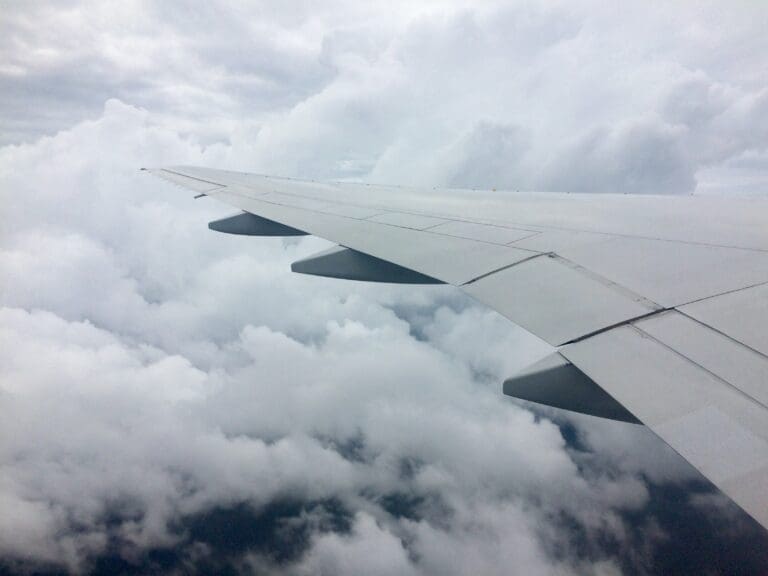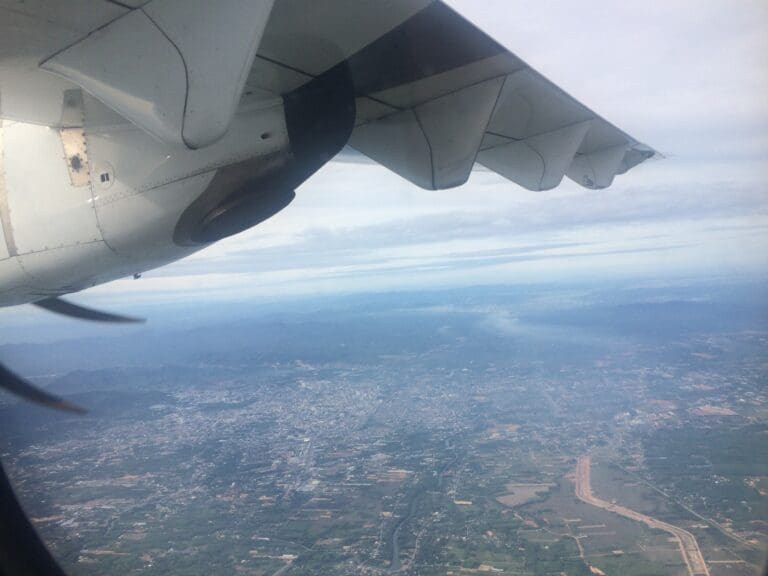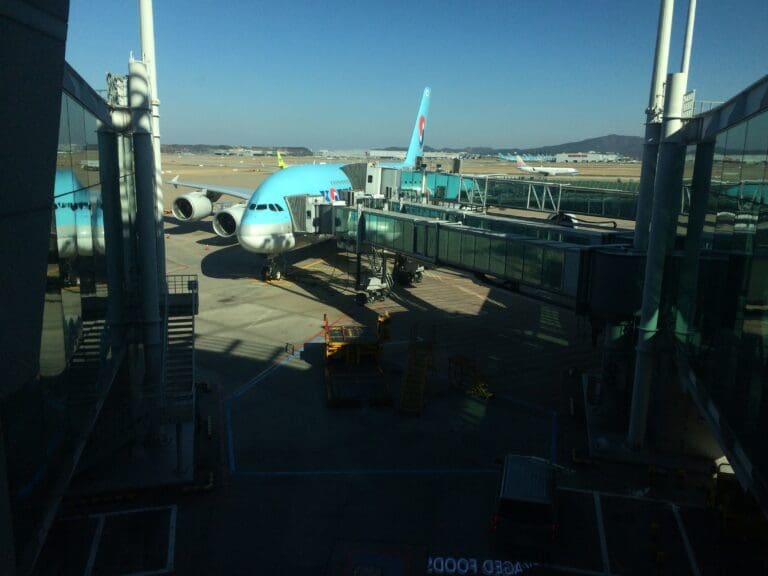Throwback Review: Korean Air’s Inaugural Boeing 787 Dreamliner Flight
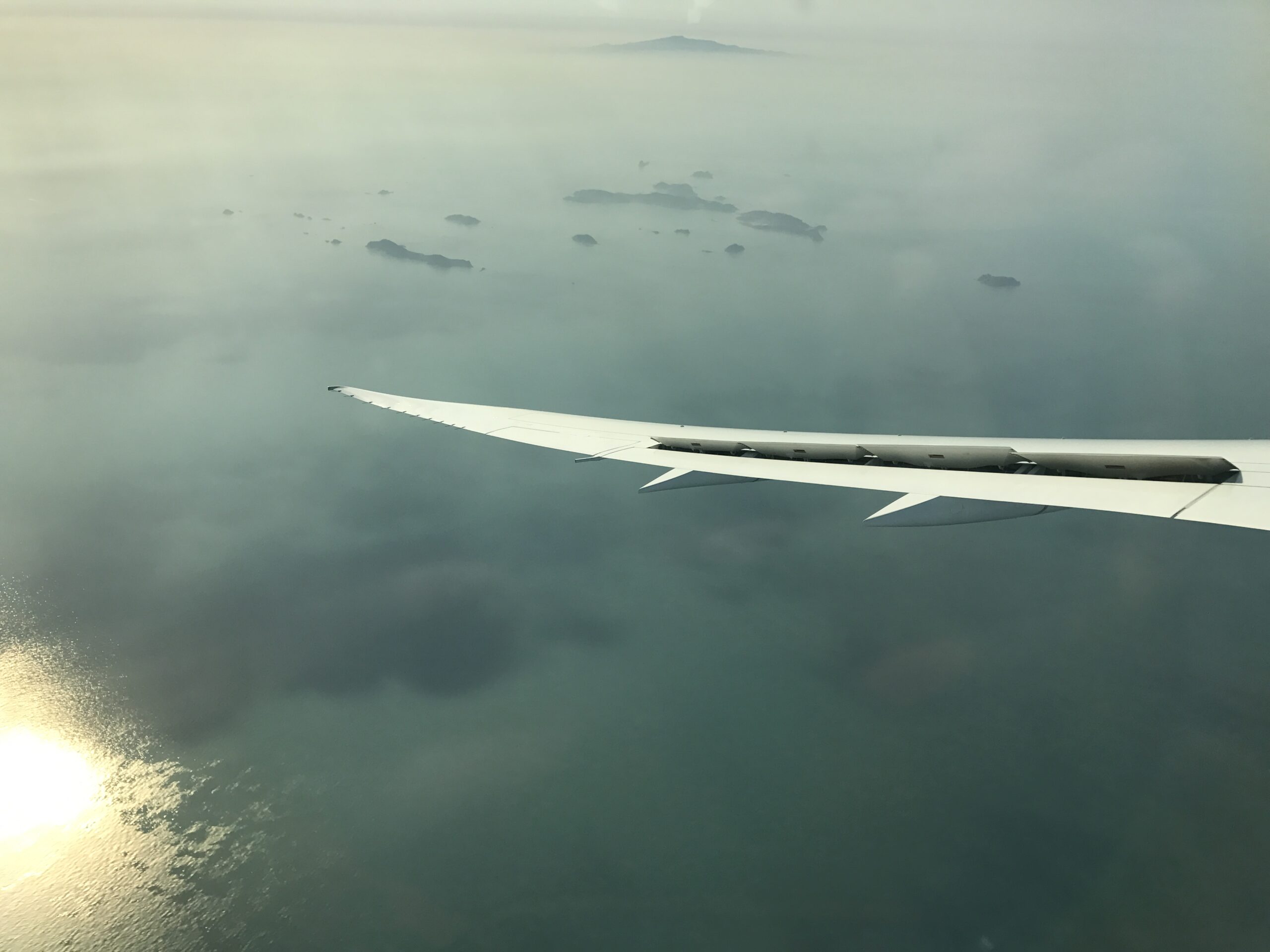
Background
Overall, I would say that I am by no means a spontaneous traveller. I rarely book travel at the last minute and instead plan things at least a few months out. However, one Saturday evening in March 2017, I found myself playing around with Korean Air’s website in an attempt to decipher when Korean Air would operate its first commercial Boeing 787-9 Dreamliner service. Korean Air’s first Dreamliner touched down on Korean soil on the 23rd of February 2017, and since then had flown training sorties between Seoul Gimpo, Seoul Incheon, Jeju, Muan and Tokyo Narita. Whilst this had been scheduled to enter service just under two weeks later flying three rotations between Seoul Gimpo and Jeju on the 7th of March, these services had not come to fruition.
Much to my surprise and delight, as it would happen, the type’s inaugural commercial service was to take place the following morning and was to take the form of Korean Air’s 0900 service to Jeju, KE1209. Fortunately, tickets for this service were still available as part of a relatively cheap return fare which I decided to combine with a Boeing 777-200ER operated service back to Seoul Gimpo at 1210 that day. Seeing as this would be my first-ever inaugural flight, I went ahead and booked with little hesitation, doing this with ease via Korean Air’s mobile app. The only slight downside to this last-minute booking was that no window seats were available to select during either booking or online check-in. Nevertheless, I was still happy to have bagged a ride on my first-ever inaugural flight. Once all was done, I was all set to head off on my morning jaunt to Jeju.
The Flight
After a few short hours of semi-decent sleep, I woke up at 0600 and had a quick shower. Seeing as I would be carrying very little bar my thick winter coat, my travel preparations did not take too long and I was out of my flat by 0620. As I headed onto the chilly morning streets of Sinchon I was greeted by the sight of armies of Saturday night drinkers looking a little worse for wear as they stumbled home and soon arrived at the station, located on Line 2 of Seoul’s expansive subway network. After a quick two-minute journey on the world’s longest circular metro line, I arrived at Hongdae Station where I transferred onto an all-stop AREX train heading towards Incheon Airport. A little over ten minutes after pulling away from Hongdae and following an intermediate stop at Digital Media City station, the train arrived at Gimpo Airport at 0655. Whilst the journey from Seoul’s western districts to Gimpo Airport can be rather quick, the journey from the station to the domestic terminal is quite a trek. After heading up several long escalators, I tapped out of the station and turned left, traversing the long and well-polished tunnel that leads to the basement of the domestic terminal. Once there, I headed up several more escalators before finally arriving in the check-in hall.
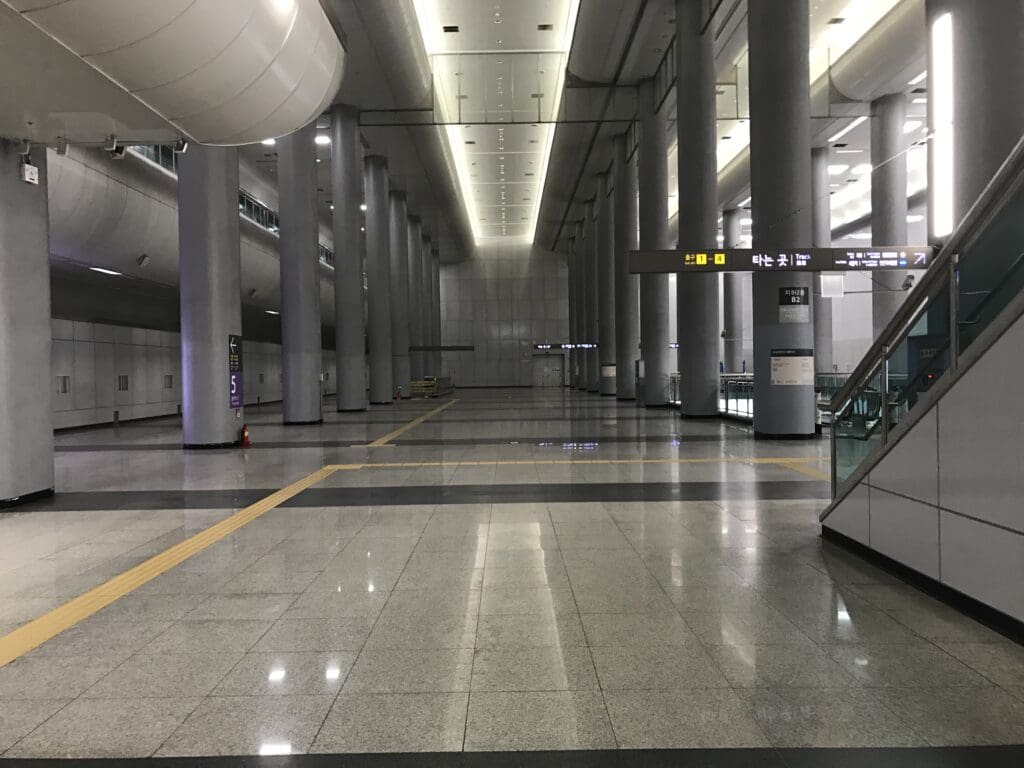
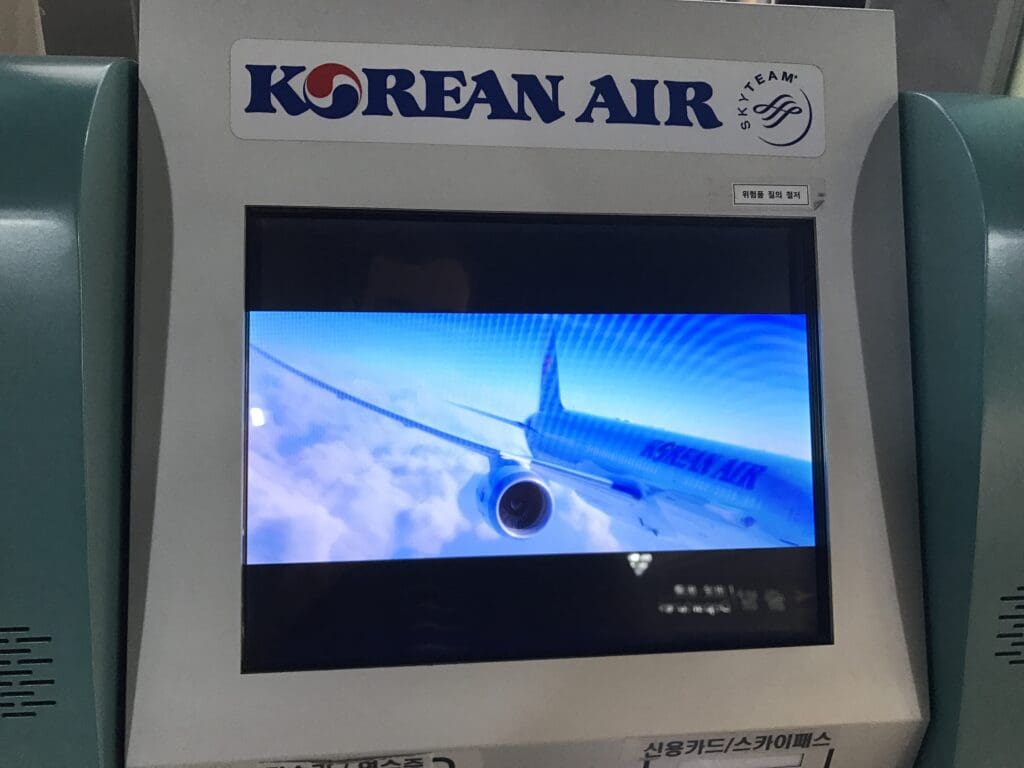
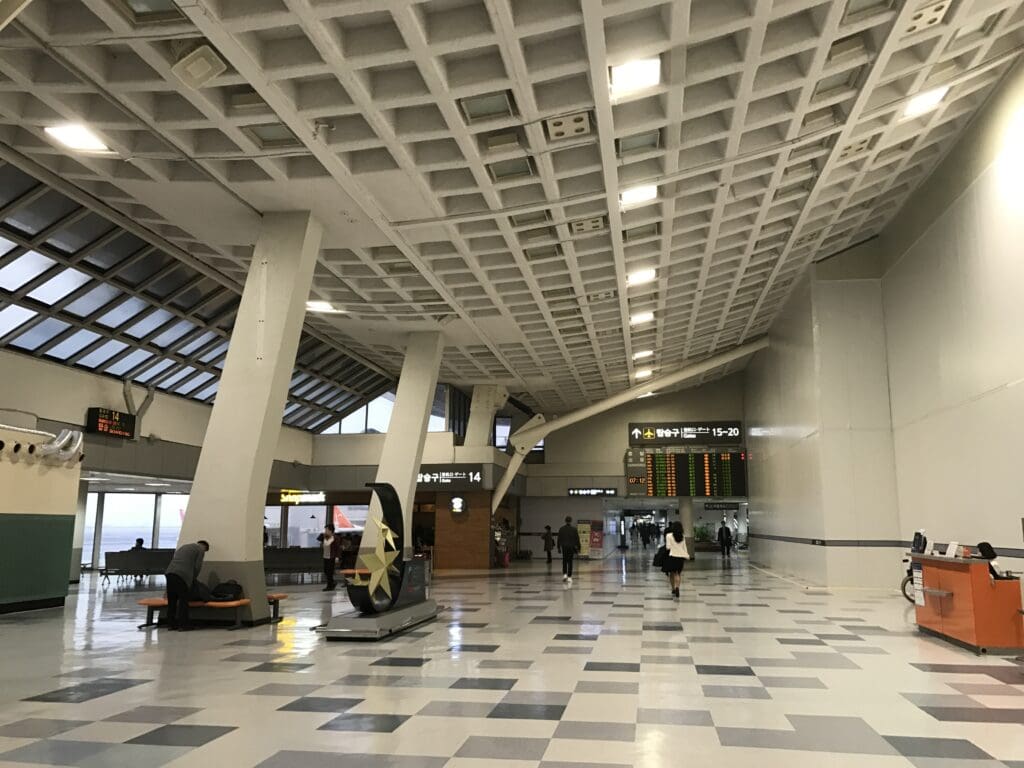
Having checked in online and had my boarding pass sent to me via the Korean messaging app KakaoTalk, there was technically no need for me to stop by Korean Air’s check-in area. However, wanting a souvenir paper boarding pass, I made my way over to one of the many Korean Air check-in machines. That morning, aside from several enthusiasts with large DSLRs who would presumably be taking the flight, there was no sign of anything special happening in the Korean Air portion of the terminal aside from the presence of several suited Korean Air executives. Unfortunately, seeing as I had already checked in, this would not let me print out a new boarding pass, and, with fairly lengthy queues for Korean Air’s Economy Class and web check-in desks, I decided to head straight up to the departure level.
Unlike the check-in area on the floor below, that morning, the domestic terminal’s identity and security check areas were largely empty. After handing over my ID card to an airport security worker, I had my mobile boarding pass checked and scanned before I was permitted to enter the security area. Thankfully, with most checkpoints open at that time, security was a quick affair and I was able to pass through with almost no queuing and without the need for any additional checks.
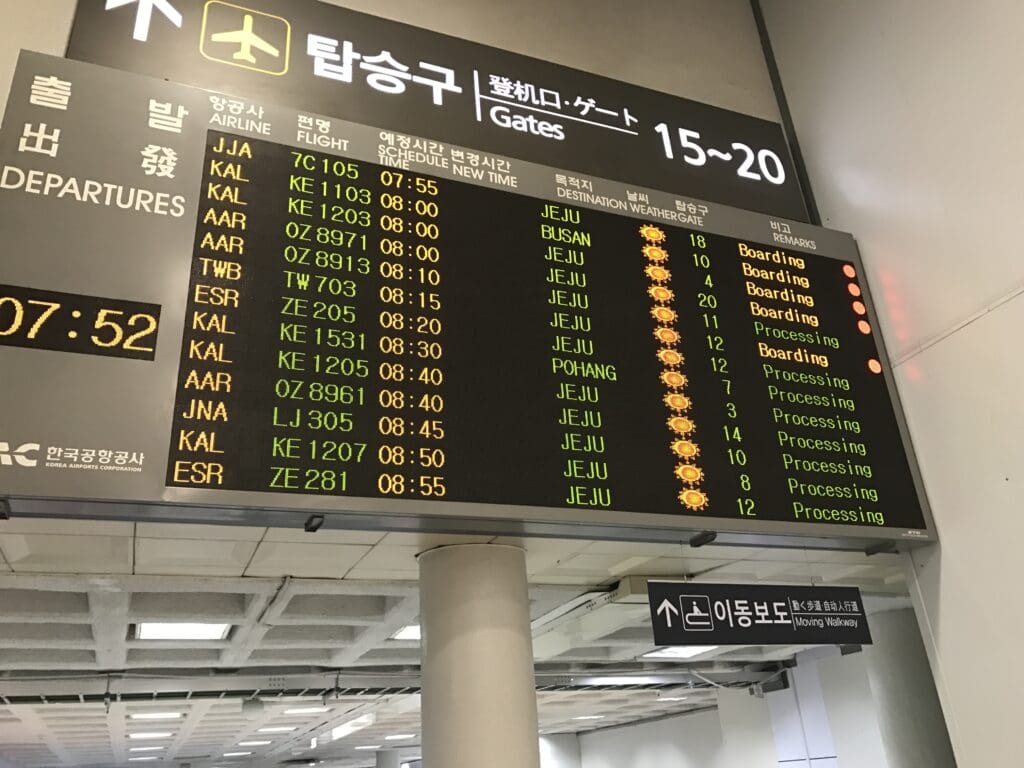
By the time I reached the airside portion of the terminal, I was left with around an hour and a half to spare until boarding was scheduled to commence. Examining the airside portion of the domestic terminal, this consists of a main atrium with two wings sticking off this. Korean Air and its low cost subsidiary Jin Air typically use Gates 1 to 13 in the terminal’s eastern end, whilst Asiana Airlines and their low cost subsidiary Air Busan make use of the west wing. Whilst fellow Korean low cost carriers such as Eastar Jet, Jeju Air and T’way Air usually slot in wherever they can find space. Thus, given this arrangement, I was rather surprised to find that that morning’s service would depart from Gate 17 at the Asiana Airlines end of the terminal.
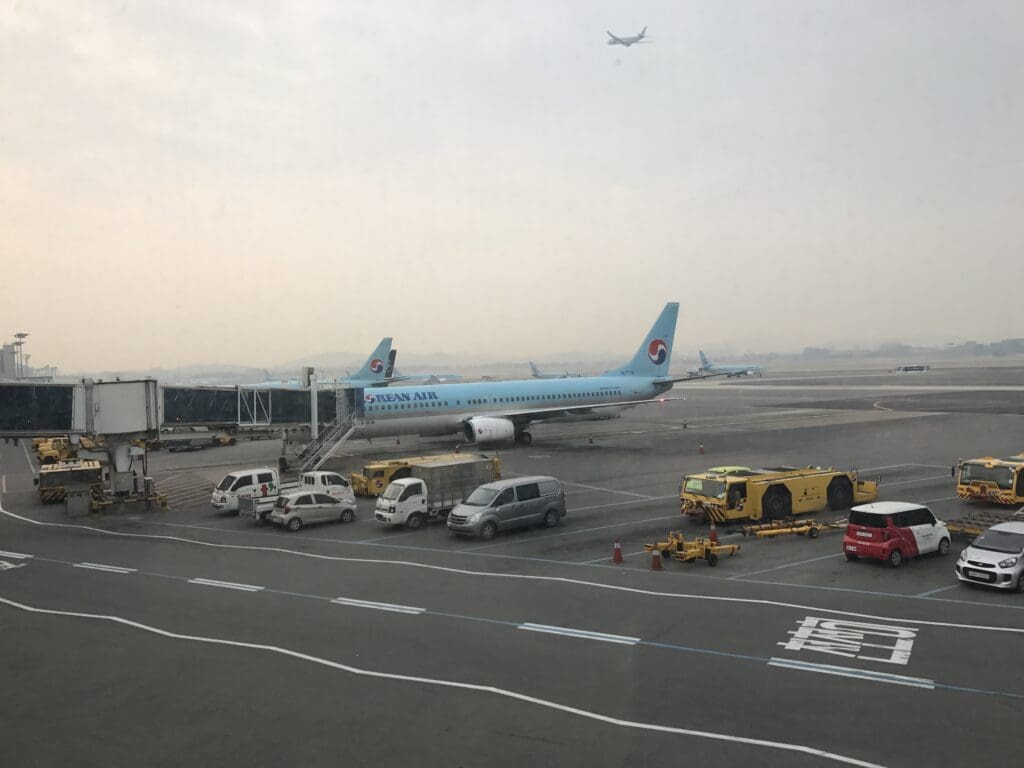
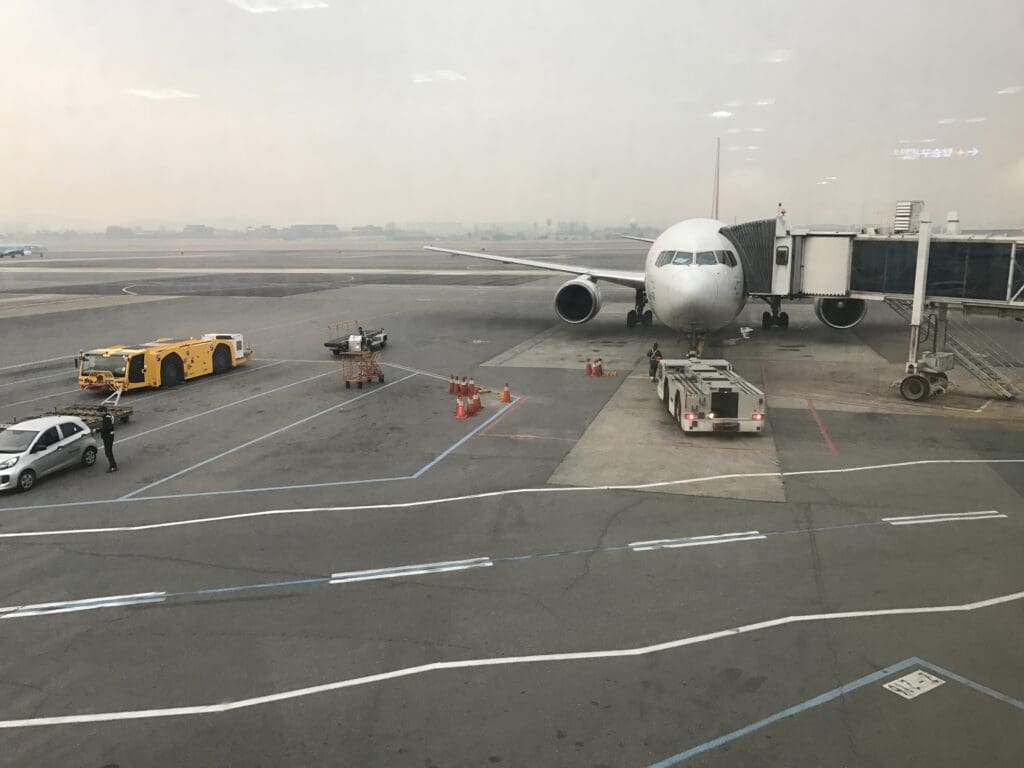
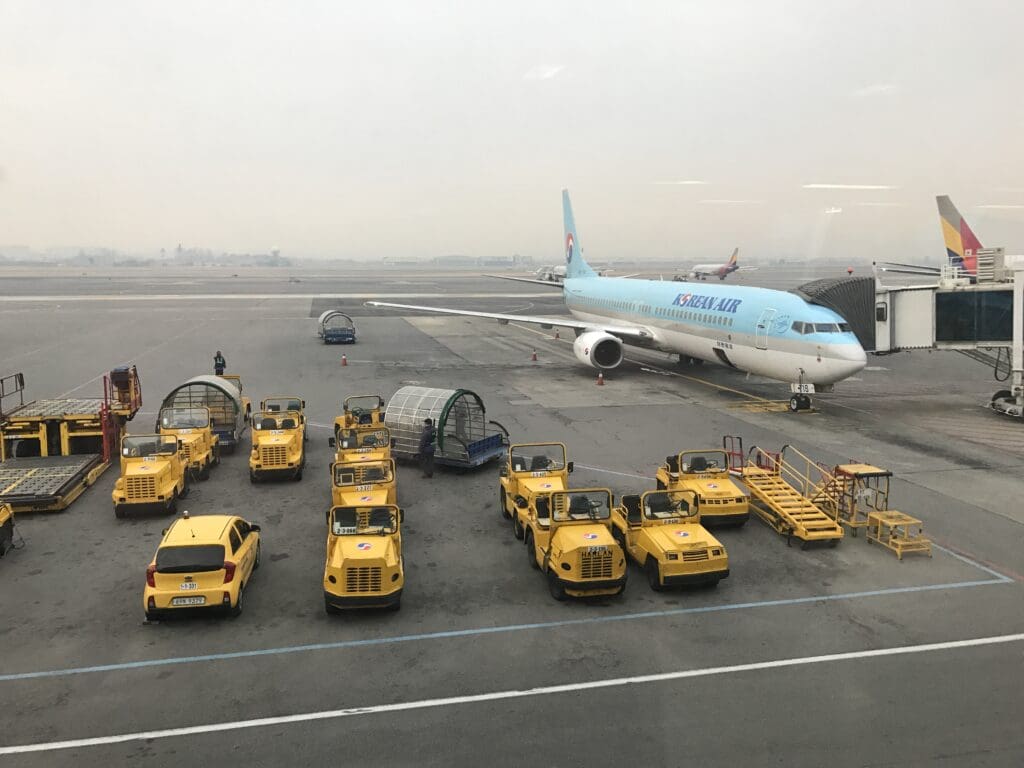
At the time of my flight in March 2017, Gimpo Airport’s domestic terminal was in the midst of a major renovation project which meant that some areas of the terminal appeared to be bright and modern, whilst others were a little more dated, and some parts resembled a building site. Nevertheless, the terminal appeared to be clean and tidy throughout, with plenty of available seating, charging points and fast complimentary wifi offered, thus leaving me with no real complaints.
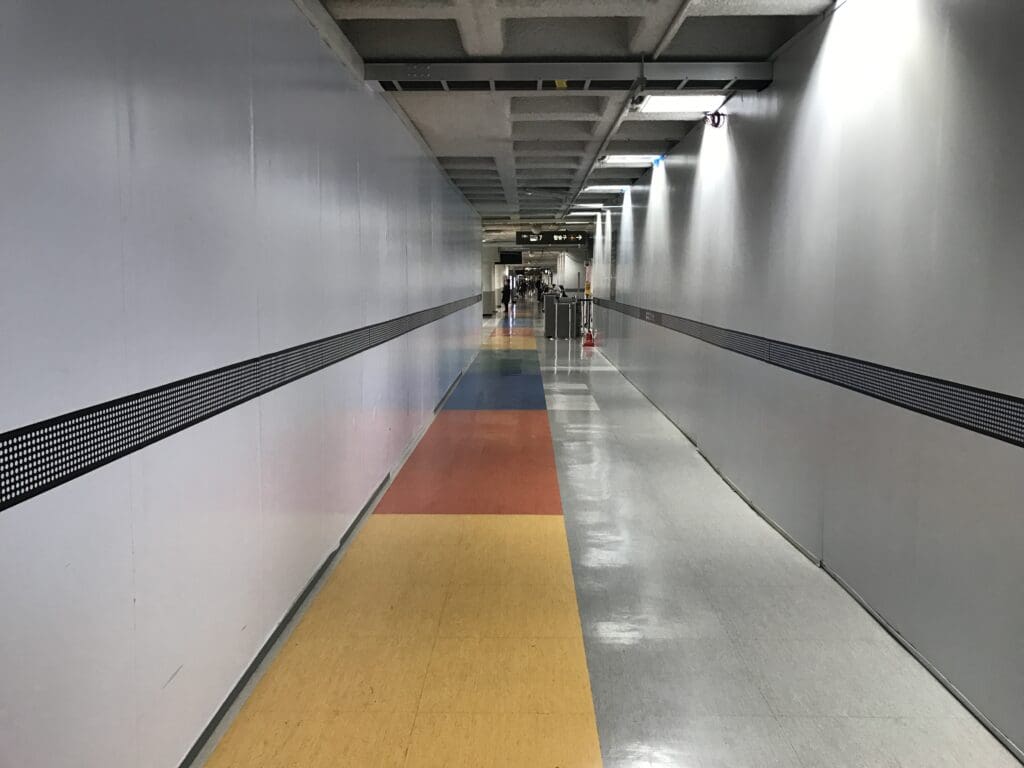
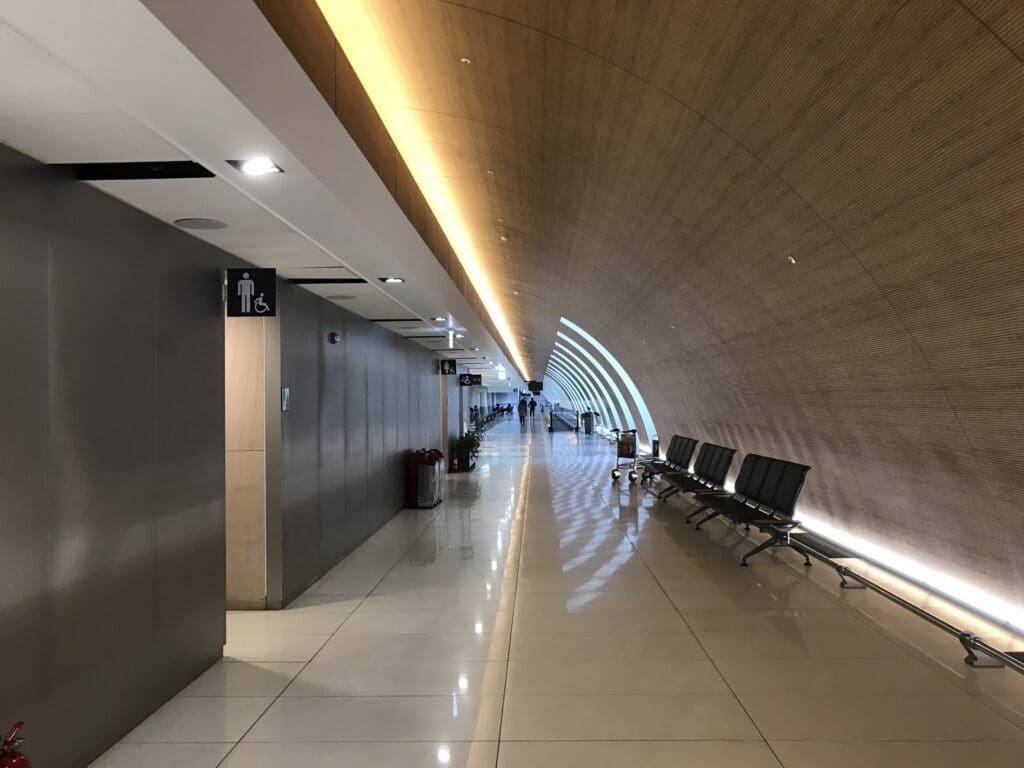
Fortunately, throughout the terminal, floor-to-ceiling windows offer a superb view of the action outside from most of the terminal’s gates. At that time in the morning, plenty of aircraft from all Korean passenger airlines, bar Air Seoul and Korea Air Express could be seen being readied to head off to Busan, Jeju, Pohang and Yeosu. There was however, no sign of Korean Air’s then-sole Dreamliner, with this parked away from the terminal at the airline’s maintenance hangars at the eastern end of the airfield. Fortunately, as soon as the Busan-bound Air Busan Airbus A320 that had been parked at Stand 17 had pushed back away from the gate, the Dreamliner was towed over to this stand. As this passed the terminal, plenty of enthusiasts of all ages could be seen snapping away – unfortunately, Gate 17 is perhaps the worst gate in the entire terminal for photography, with two layers of glass preventing any good shots of the sleek Dreamliner outside.
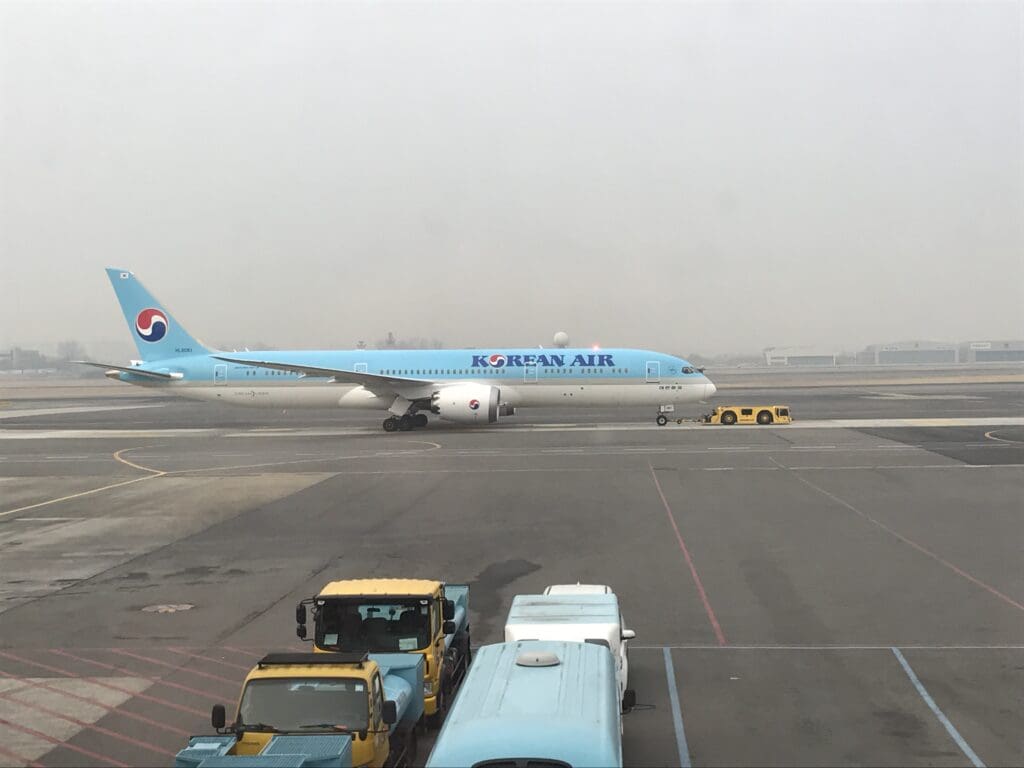
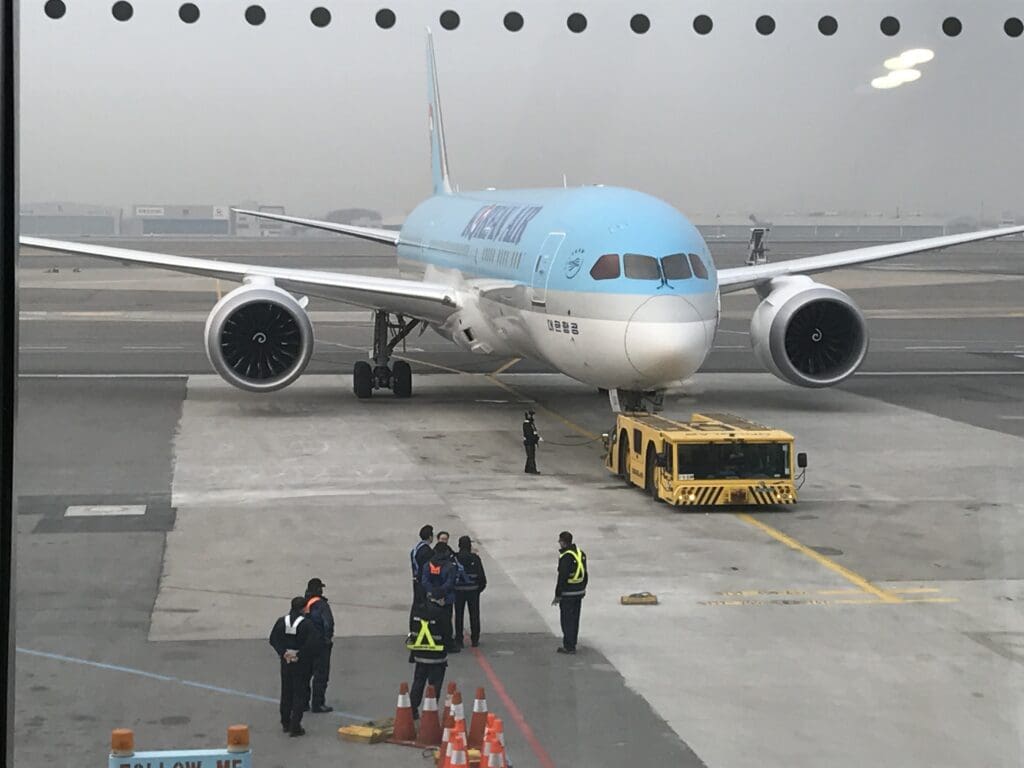
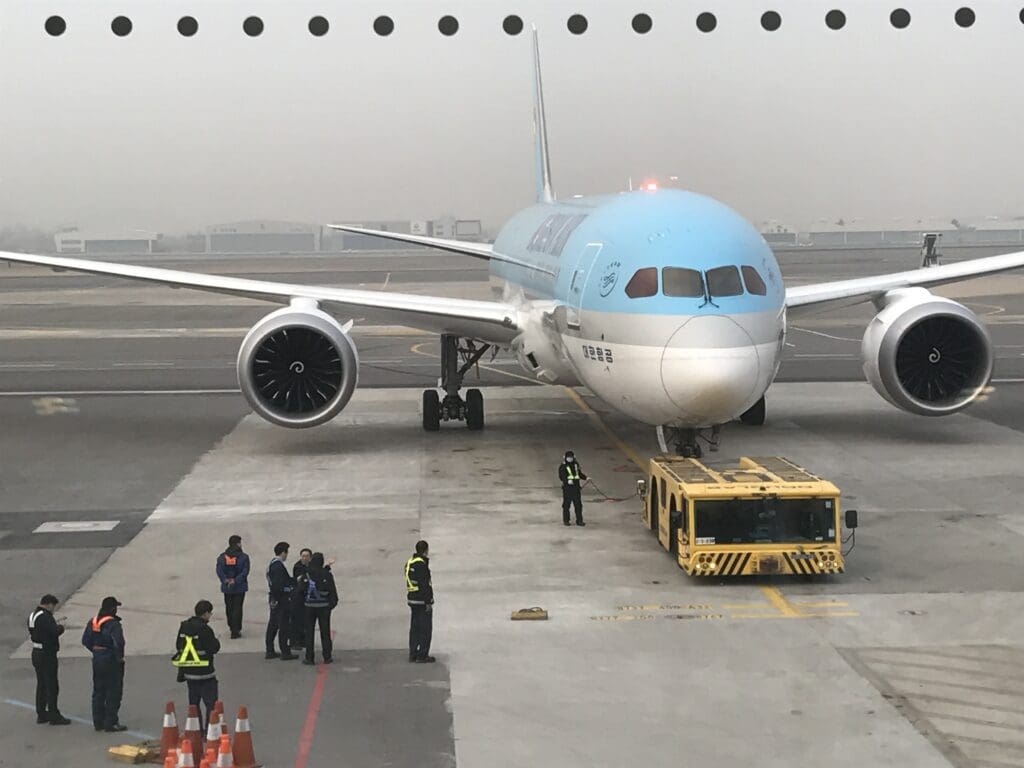
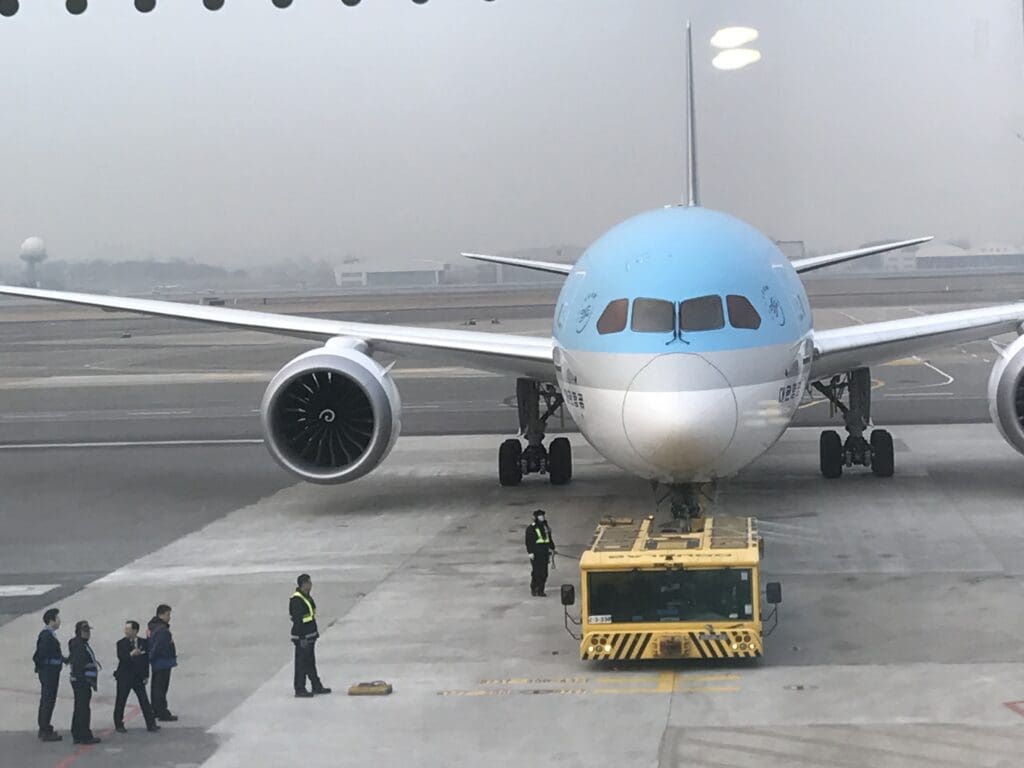

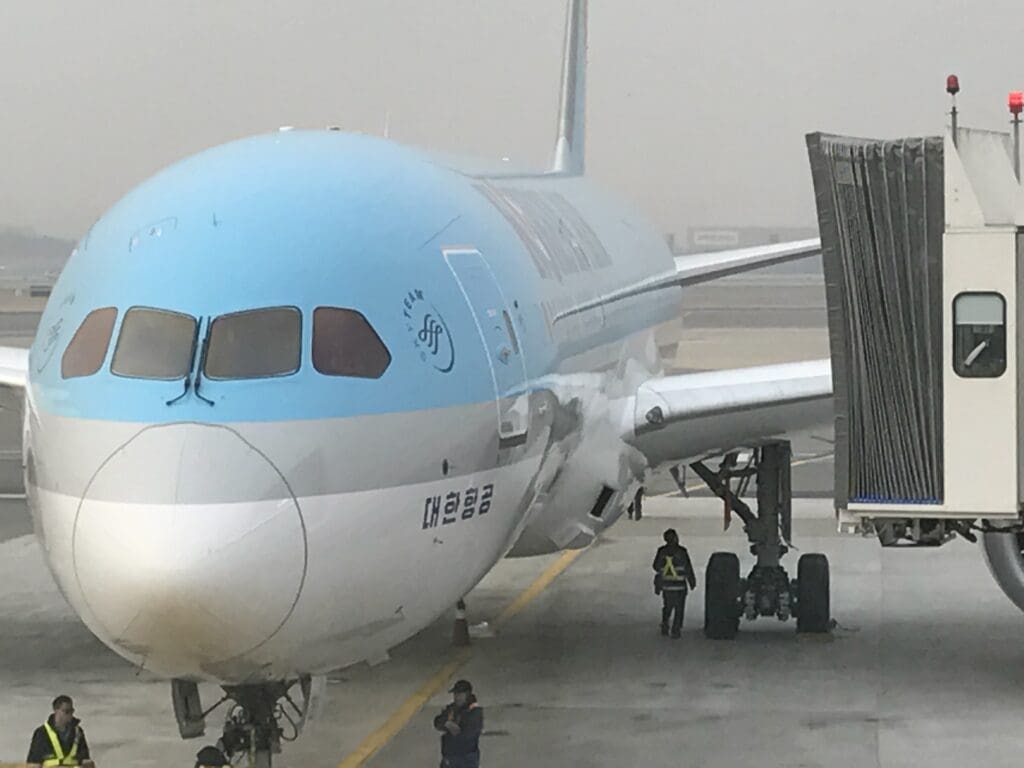
Except for the many enthusiasts, there was little to indicate that this flight was particularly special. However, outside on the ramp, the aircraft could be seen garnering much attention from both suited officials and ramp workers. As had been expected, the aircraft for the flight flight took the form of HL8081. This particular Dreamliner was manufactured at Boeing’s South Carolinian plant in Charleston and first took to the skies in late January 2017. Just under a month later, Korean Air took delivery of the aircraft and this made the long flight over to Seoul Incheon as KE26D. In the weeks that followed, as one would expect from any new type, the Dreamliner undertook a series of crew familiarisation flights during which it visited airports across Korea and even visited Tokyo Narita Airport.
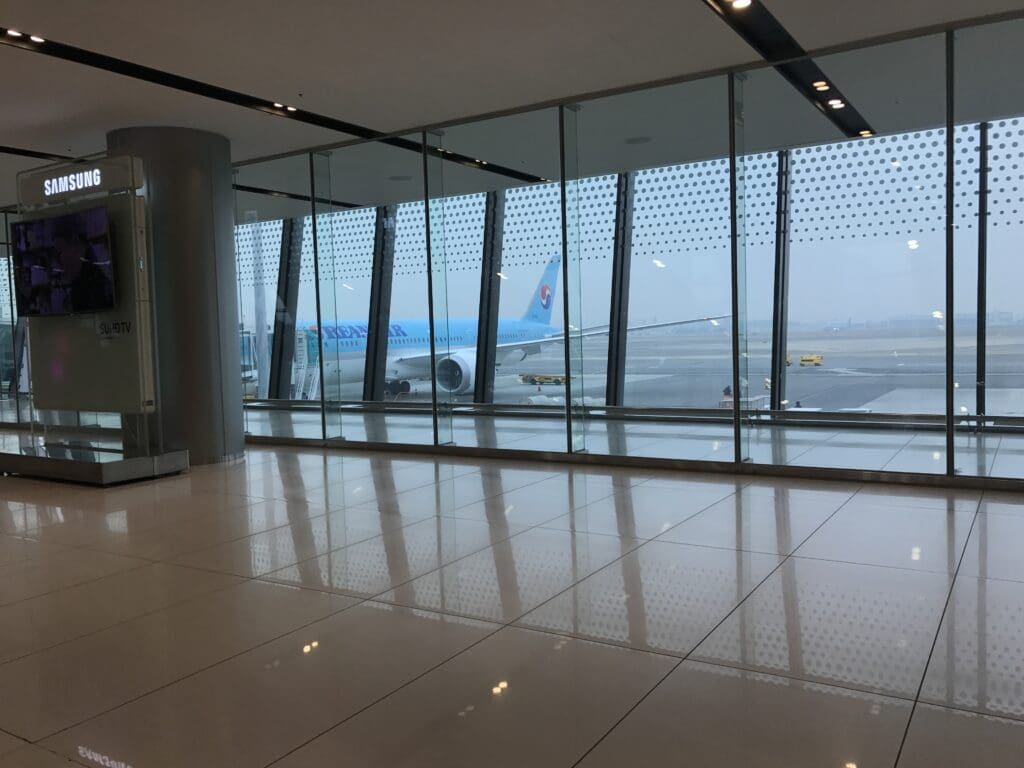


Onboard, the aircraft features a total of 269 passengers and initially came in a three-class configuration. However with identical APEX suites in both First Class and Prestige Class, today Korean Air’s Dreamliners operate in a two-class configuration with 24 seats in Prestige Class and 245 Economy arranged in the standard 3-3-3 configuration. This configuration means that the aircraft carries slightly fewer passengers than many other two-class Boeing 787-9 Dreamliners, including those of LATAM, Oman Air, Saudia and Turkish Airlines.
Inside the terminal, as the flight’s scheduled boarding time approached, the gate area gradually became busier and most seats around this ended up being taken. Despite being a large widebody aircraft, boarding was scheduled to commence just twenty minutes before the flight’s scheduled departure time, with this being the standard boarding time for many domestic flights in Korea, regardless of aircraft size! Following a short queue, my mobile boarding pass was scanned before I made my way down the glass jetbridge towards the brand-new Dreamliner. With the jetbridge connected to the aircraft’s L1 door, following another short wait, I stepped into the forward galley where I received a warm and friendly greeting in English and Korean from no fewer than three flight attendants standing there. Once one of the flight attendants had checked my boarding pass, I was directed down the second aisle and made my way into the aircraft’s cabin.
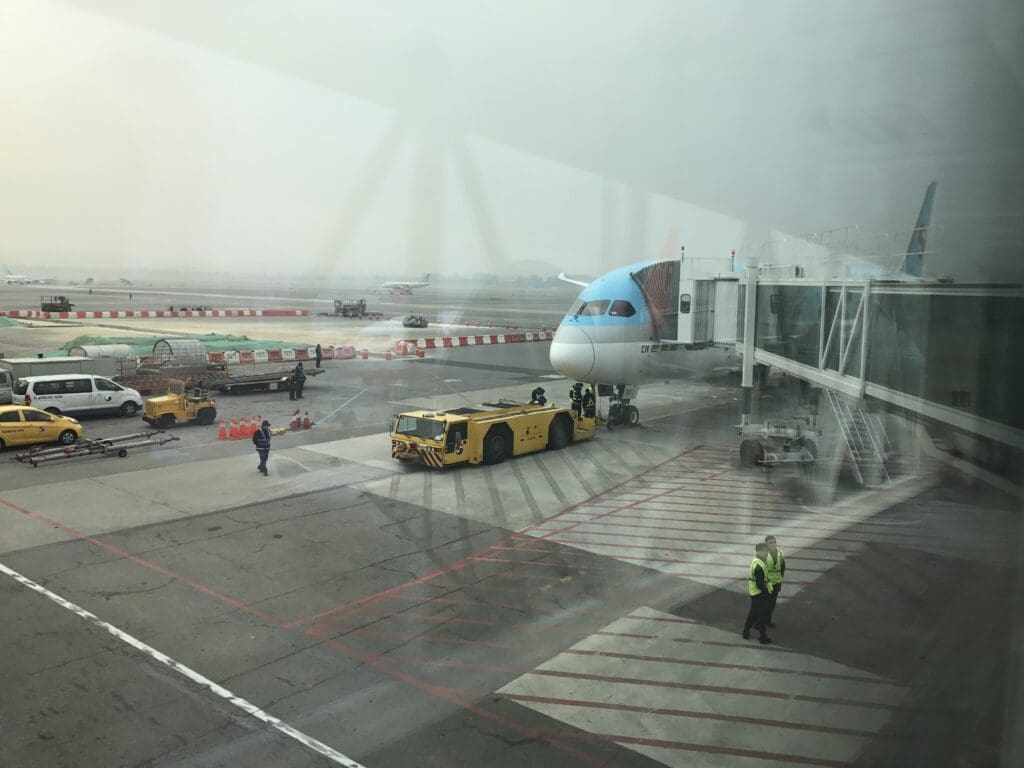
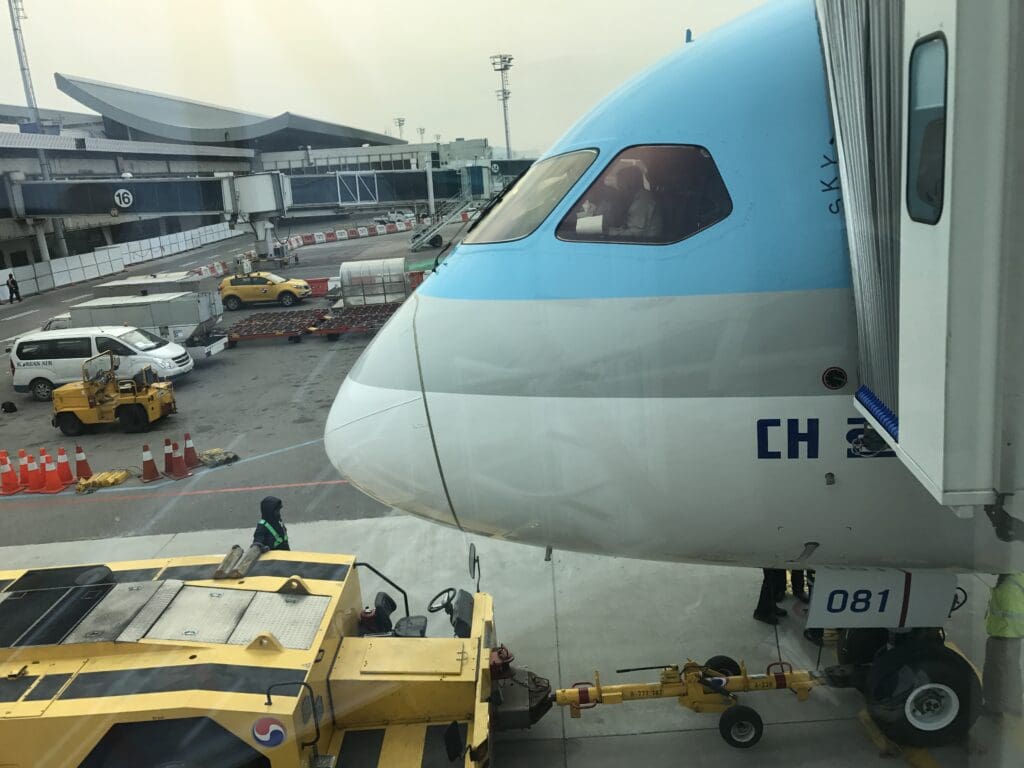
First up on my journey to my seat was the unusual single row of four luxurious and comparatively private First Class APEX suites, each of which was covered in a slightly clinical-looking turquoise fabric cover. Steaming through this section, I passed through the cherry blossom pattern adorned cabin divider and entered the larger Prestige Class cabin, where again, luxurious APEX suites could be seen. Whilst I am by no means au fait with any premium product, these are by far a cut above the older privacy-lacking Prestige Class seats onboard Korean Air’s Airbus A330s, Airbus A380s and older Boeing 777s, however, I should note that these aircraft are being retrofitted with these seats.
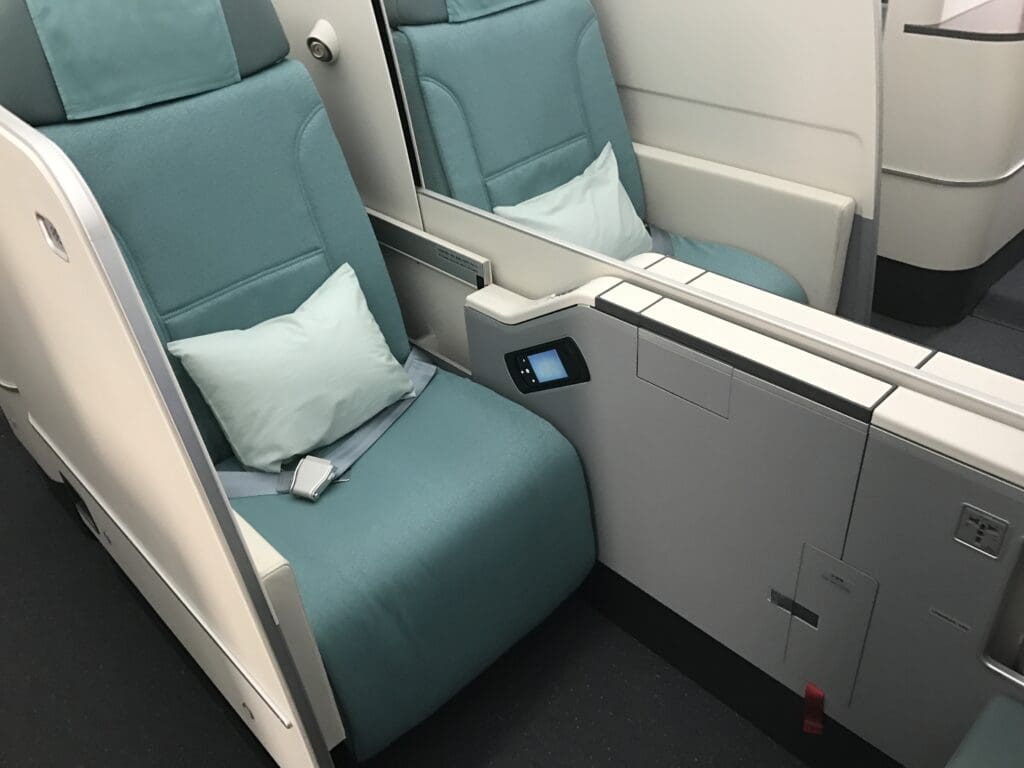
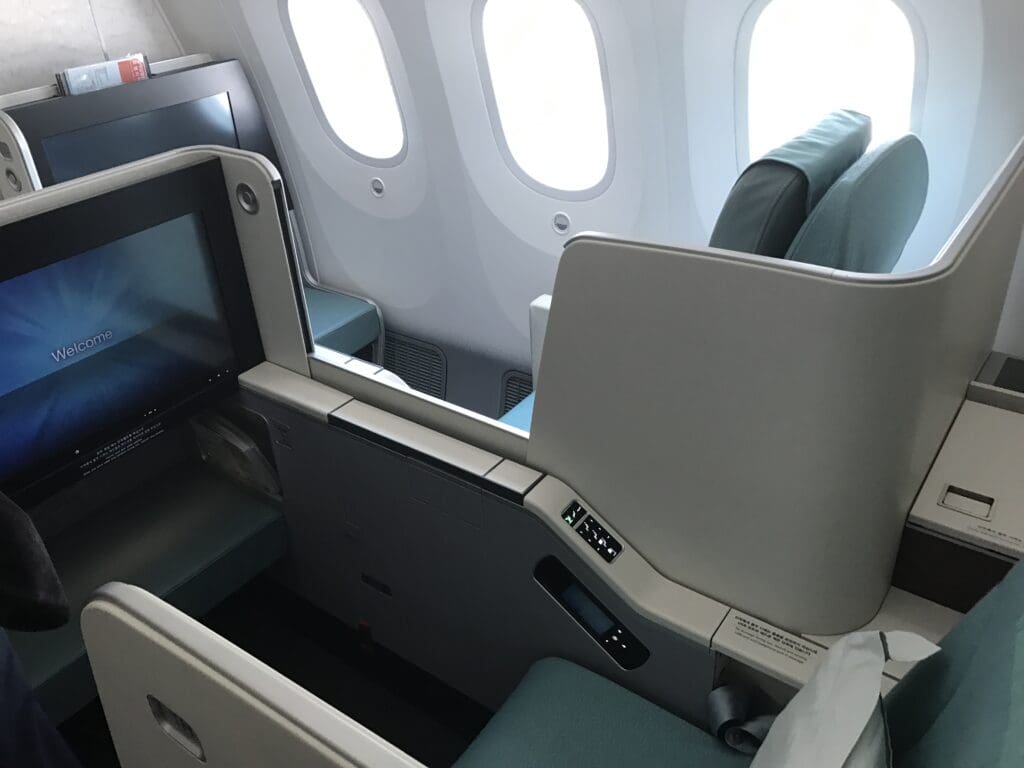
Next up was the Dreamliner’s forward Economy cabin where rows of Collins Aerospace Pinnacle seats could be seen. Unfortunately, Korean Air opted against refreshing their longstanding plain cabin design, and each seat sported the airline’s brown or blue fabric covers which feature a repeating isometric pattern. Each seat comes with a bifold tray table, a coat hook, a seatback pocket and a literature compartment, alongside a 10.6 inch wide touchscreen inflight entertainment screen powered by Thales’ AVANT system, a USB-A port and a universal power outlet.
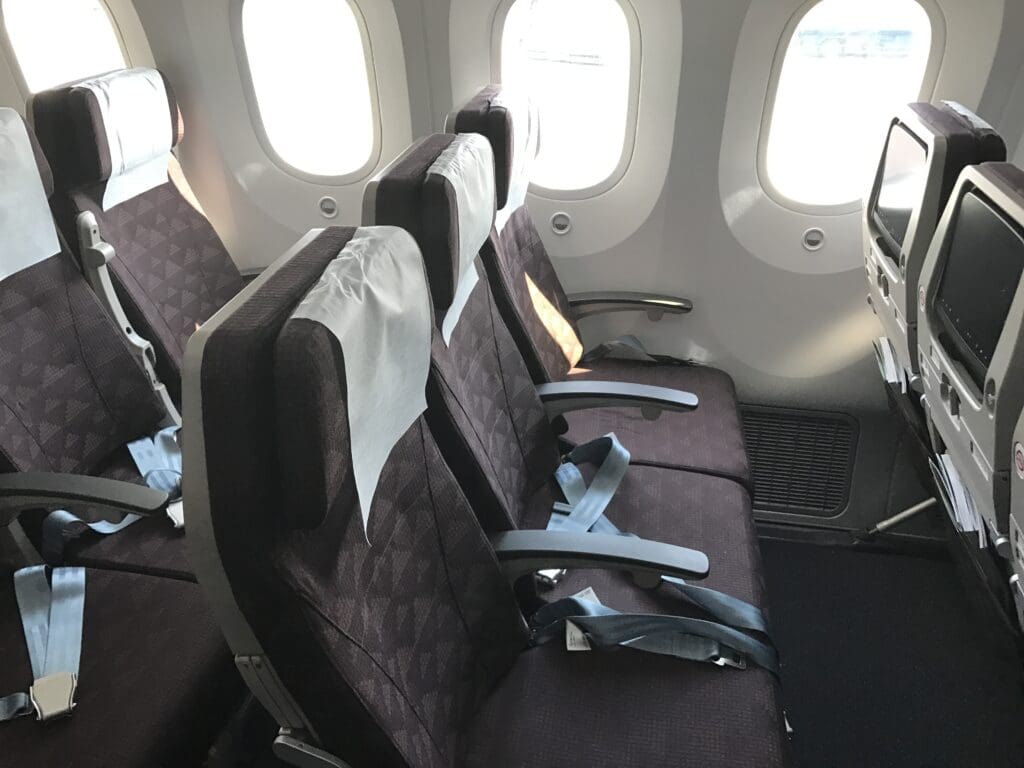
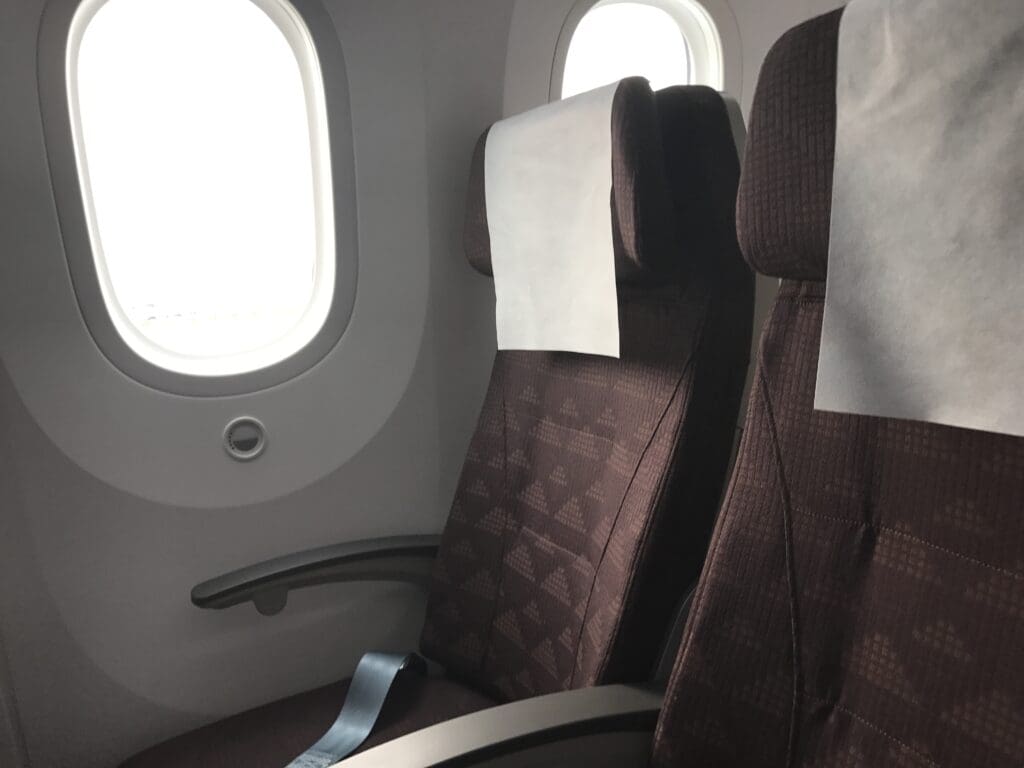
As I made my way down the aircraft, I received multiple polite and friendly greetings and soon reached my seat, 50G, in the Dreamliner’s rear Economy cabin. As tends to be the case with most Korean Air jets, once seated, I found the seat to be highly comfortable and offer an abundance of legroom. Meanwhile, as was to be expected given the fact that this was the aircraft’s first commercial service, the seat and the area around this were in mint condition, being both spotlessly clean and lacking any noticeable signs of wear and tear. Examining the contents of the seatback pocket, this contained a sickbag, two safety cards (presumably to allow for any light fingered enthusiasts looking to take a souvenir), the latest copy of Korean Air’s monthly Morning Calm magazine and the SkyShop catalogue. Further indicating that this was not a standard flight, during boarding, plenty of passengers could be seen wandering around the cabin, snapping photos, something which did not cause any issues with the crew onboard who were perhaps likely expecting an unusually high number of enthusiasts that morning.
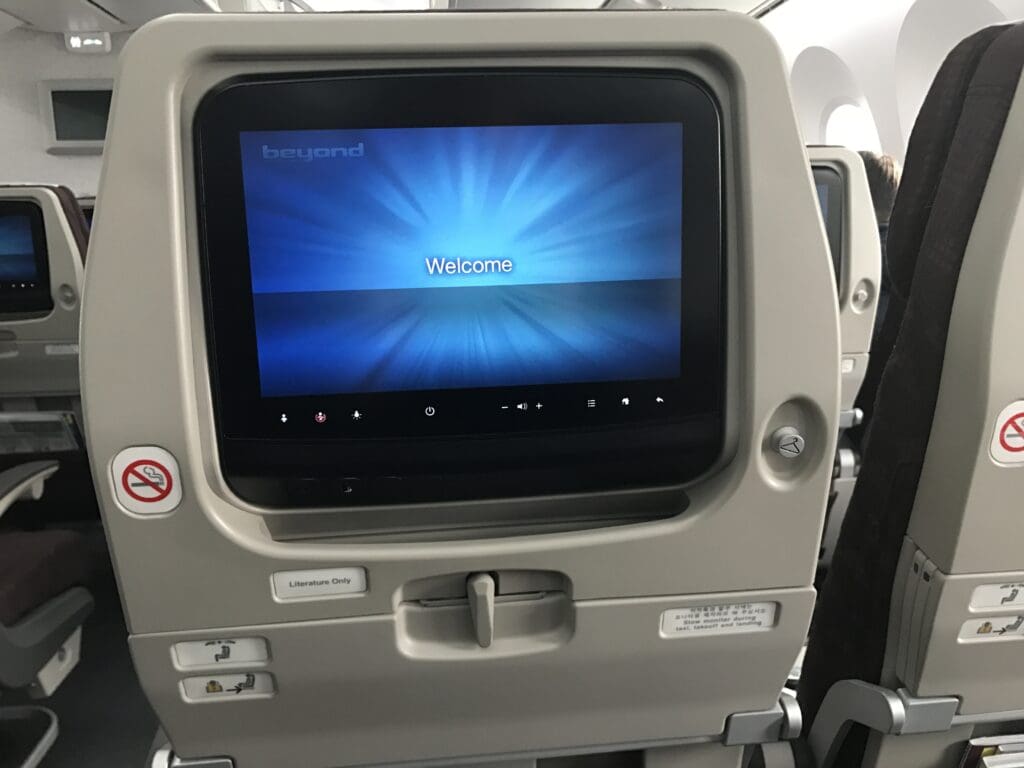
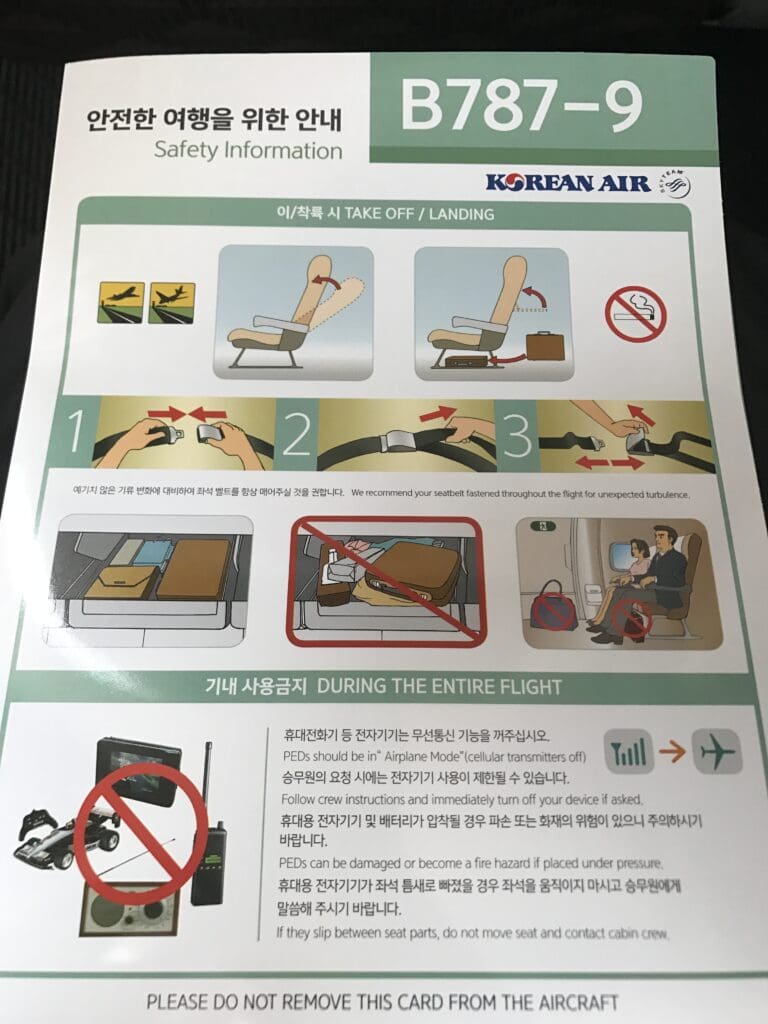
That morning, boarding did not take too long and for most of this, both the window and aisle seat remained empty. However, unfortunately, the window seat ended up being taken by one of the last passengers to board the flight. Nevertheless, I was in luck, as the flight was no more than 65% full in Economy and I was able to shift across to Seat 50A, enabling me the luxury of a window seat on the short hop to Jeju. Fifteen minutes after boarding had commenced, at 0855, the Purser announced boarding as complete, the L1 door was soon closed and the jetbridge was backed away from the aircraft.
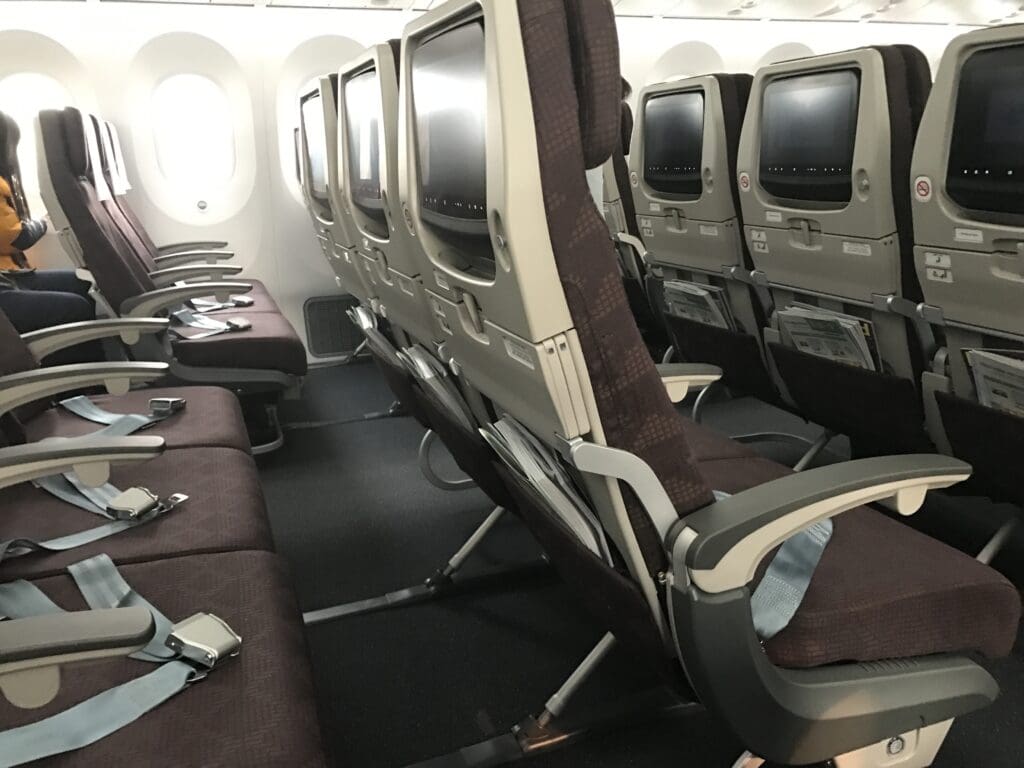
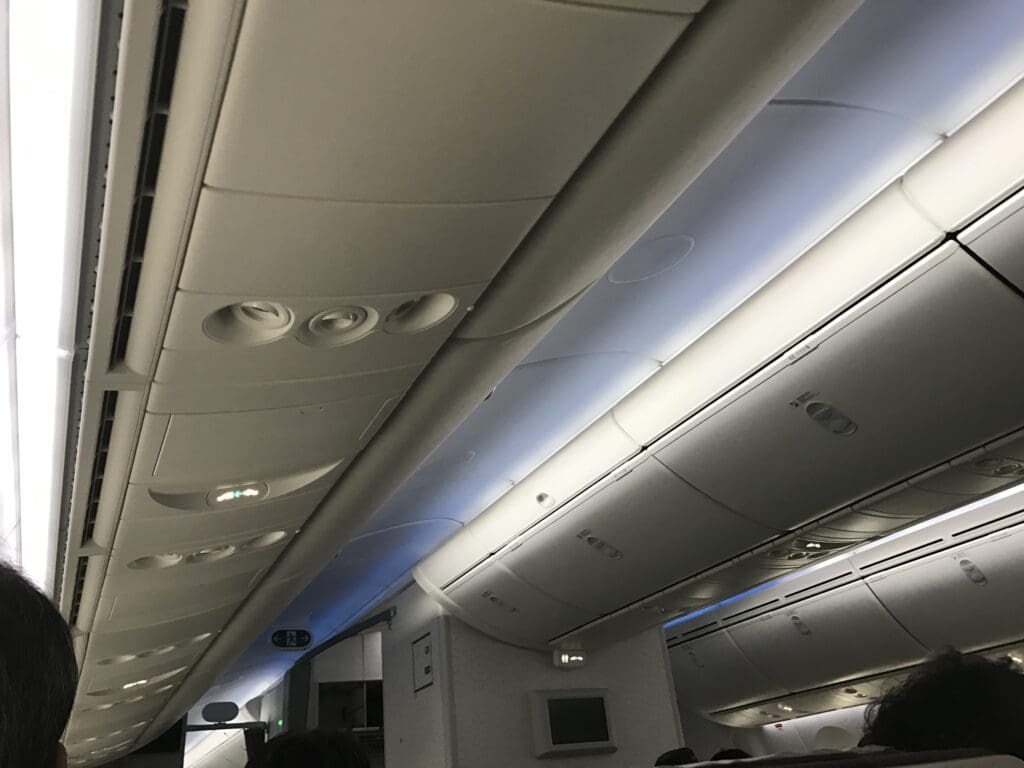
Almost immediately after boarding came to an end, the Purser welcomed all passengers onboard, thanked passengers for flying with Korean Air and noted that our flight time would be 55 minutes. This was undertaken in Korean and English, which was then followed by a generic pre-recorded welcome announcement in Mandarin. As soon as the pre-recorded announcement came to an end, Korean Air’s rather dated safety video took over the inflight entertainment screens. This consists of part-real part-animated video, with the ‘real’ scenes shot in one of Korean Air’s Airbus A300s and Boeing 777s around the turn of the millennium. Despite its age and dated appearance, this video serves its important purpose in clearly highlighting the safety procedures onboard.
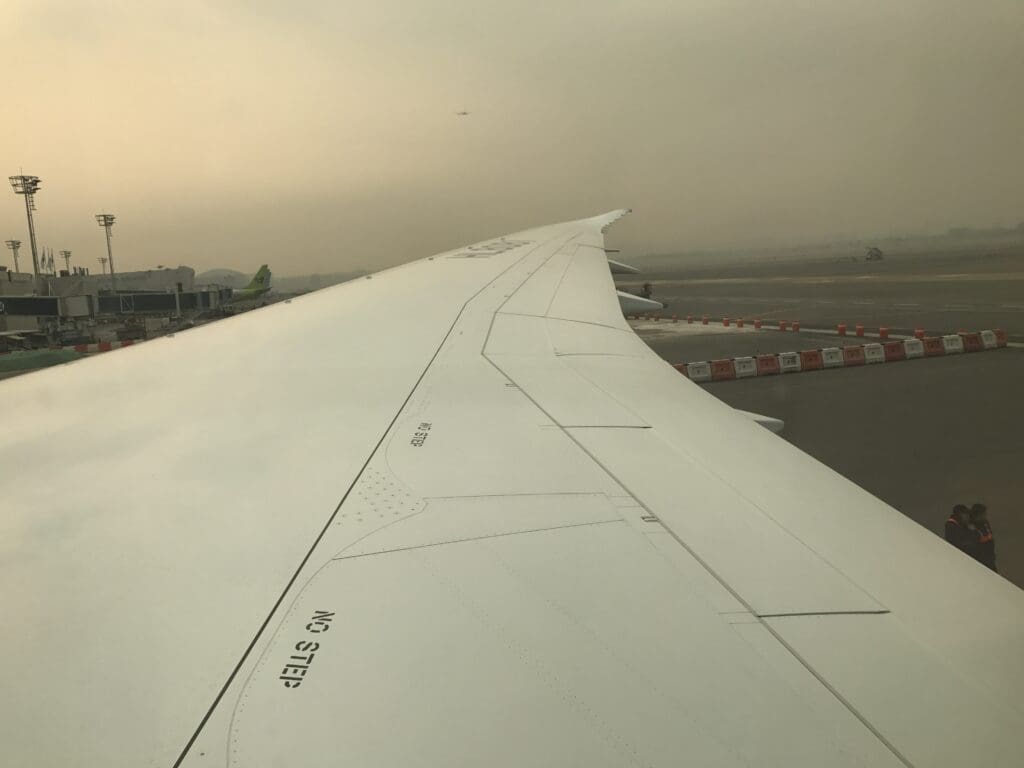
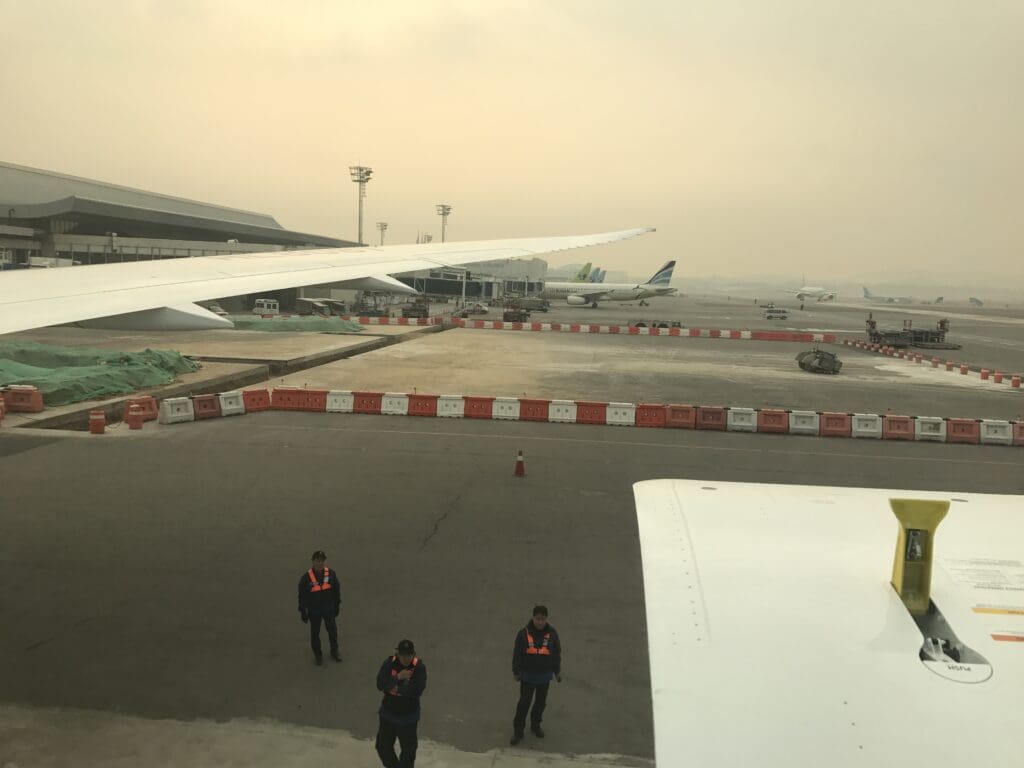
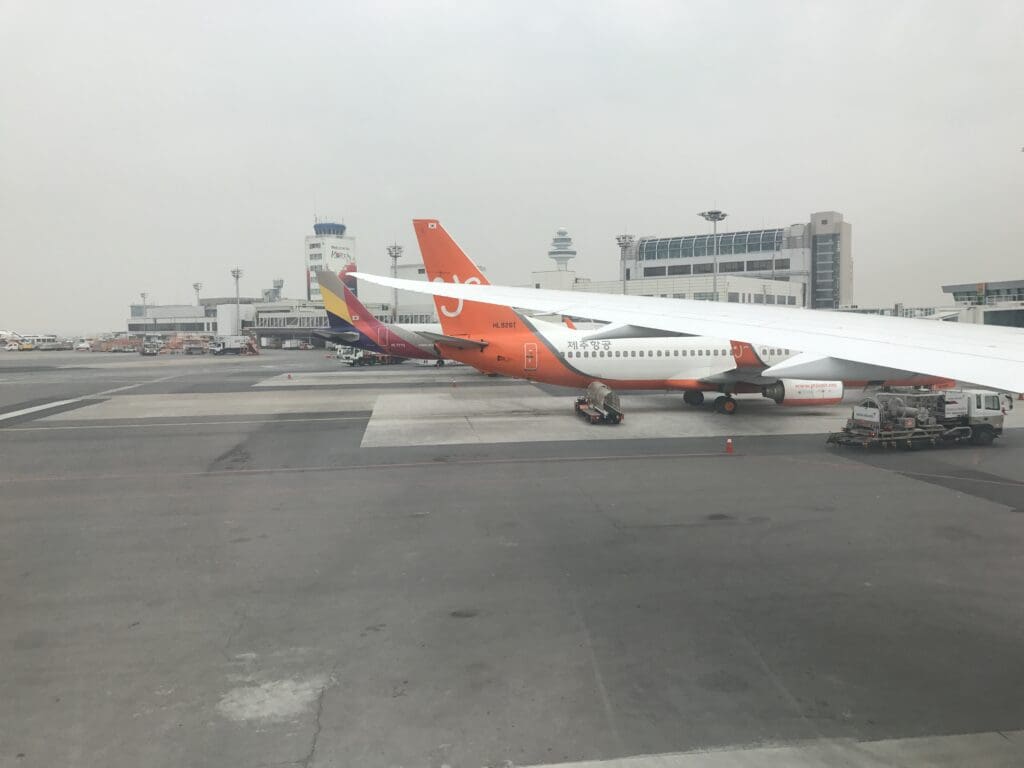
Looking outside, as the safety video played, all preparations for our departure appeared to have been completed and at 0906 the aircraft was pushed back away from its stand. Once the Dreamliner came to a halt, the cabin fell near silent allowing for all the whirring and whining of the two massive GEnx-1B engines to be heard as these powered into life ready for the aircraft’s short hop to Jeju. A few minutes later, the ground crew waved us off as the jet commenced its fairly long taxi to the end of Runway 14L. Seated on the left hand side of the aircraft, during this taxi I was offered a good view of four departing Jeju bound aircraft. These consisted of two Korean Air jets – a Boeing 737-900 and a Boeing 777-200ER, alongside two Boeing 737-800s operated by low cost carriers Jeju Air and T’way Air.
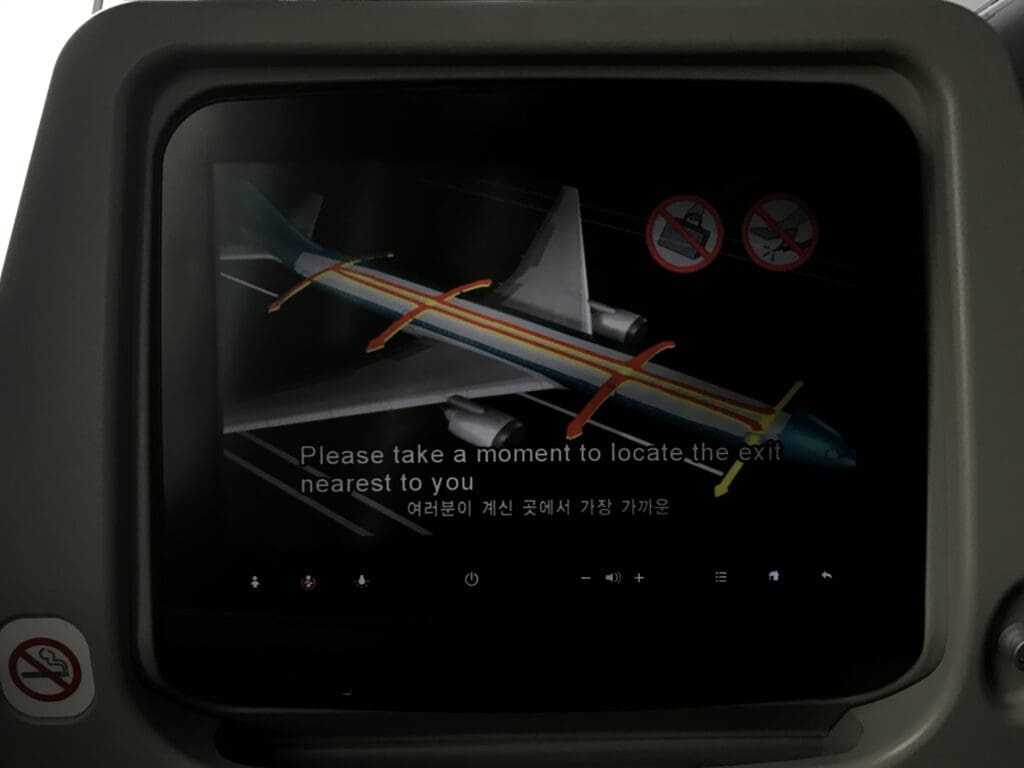

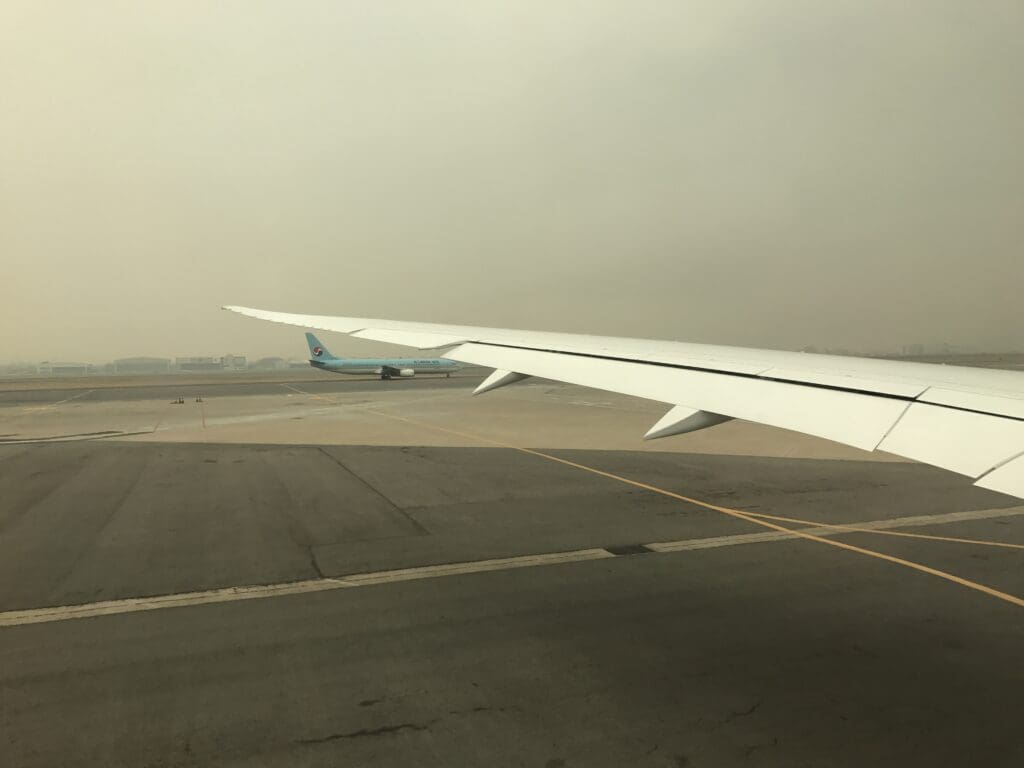
After a few minutes, the Dreamliner reached the end of the runway where we held for a few moments before taxiing onto this and coming to a halt for two minutes. Eventually, the two General Electric engines roared into life and we began to hurtle down the runway. Unsurprisingly considering that the aircraft was presumably rather lightly loaded, our takeoff roll was short and powerful, and we soon rose upwards into Seoul’s murky early spring sky. Whilst many people seem to comment on the quietness of the Boeing 787, to be honest the only airliner I have noticed to be significantly quieter than others is the Airbus A350 – although admittedly I do not have quantitative evidence to back this up! Once in the skies the landing gear was soon retracted, followed a short time later by the flaps as the aircraft banked right to turn onto a southerly heading.

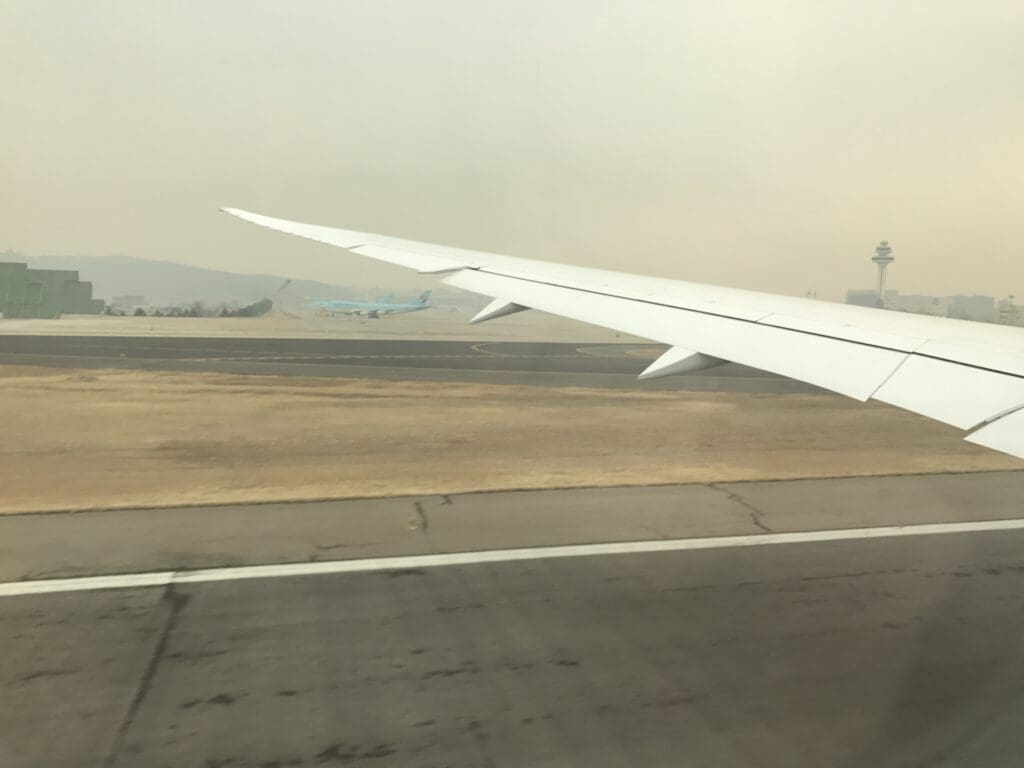

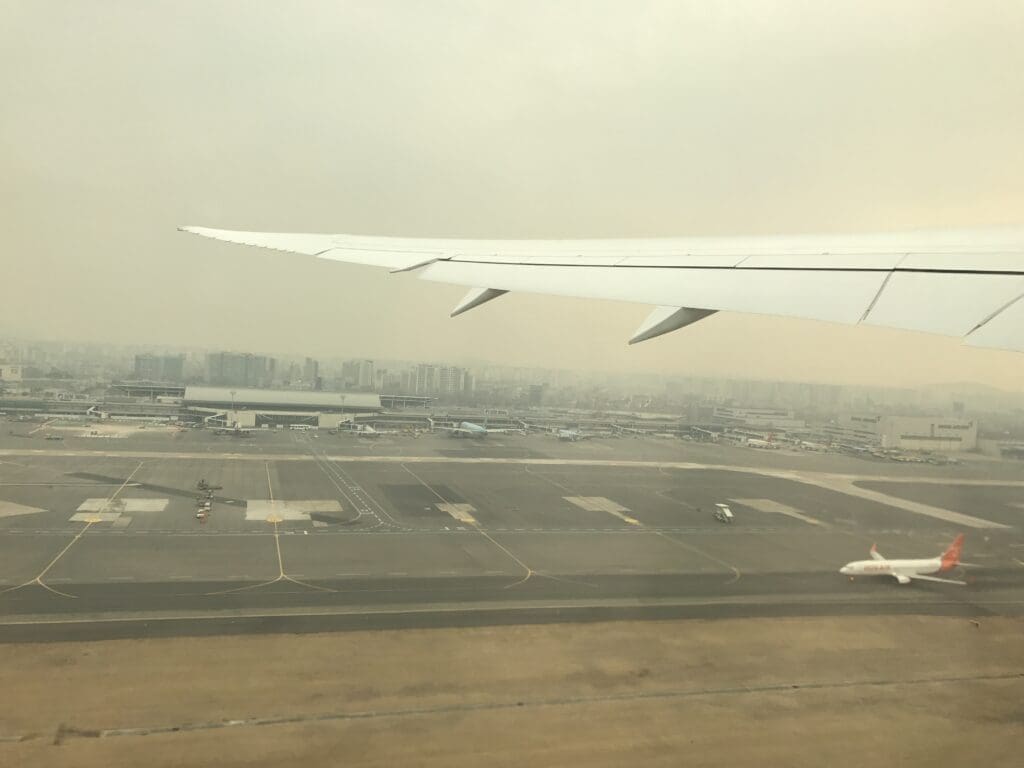
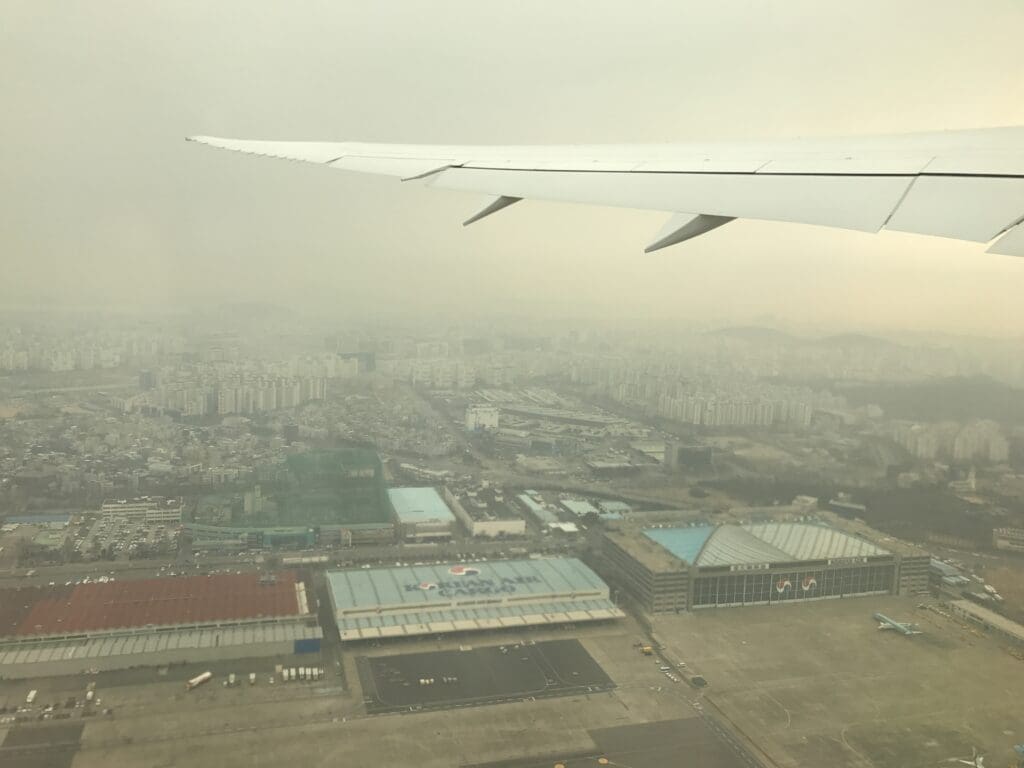

As the aircraft climbed through 10,000 feet the sign belt signs were extinguished and a short time later, we levelled off at our comparatively low cruising altitude of 27,000 feet. Whilst Korean Air may be known for its bibimbaps, given the short flight times of their domestic flights, the service onboard these is limited to nothing other than a non-alcoholic drink, regardless of whether you are travelling in Economy or Prestige Class. Approximately fifteen minutes after rocketing into the skies, in line with any other Korean Air domestic flight, the crew took the aisles and offered passengers coffee, juice, water or cold barley tea. Upon reaching my row, a very polite flight attendant offered me a drink and I decided to go for a cup of Jeju gamgyul juice which was served in a Korean Air branded paper cup and accompanied by a serviette that featured Korean Air’s logo and that of the 2018 Pyeongchang Winter Olympics. They then offered me a second drink, although I declined and they continued onwards, with the service soon coming to an end.
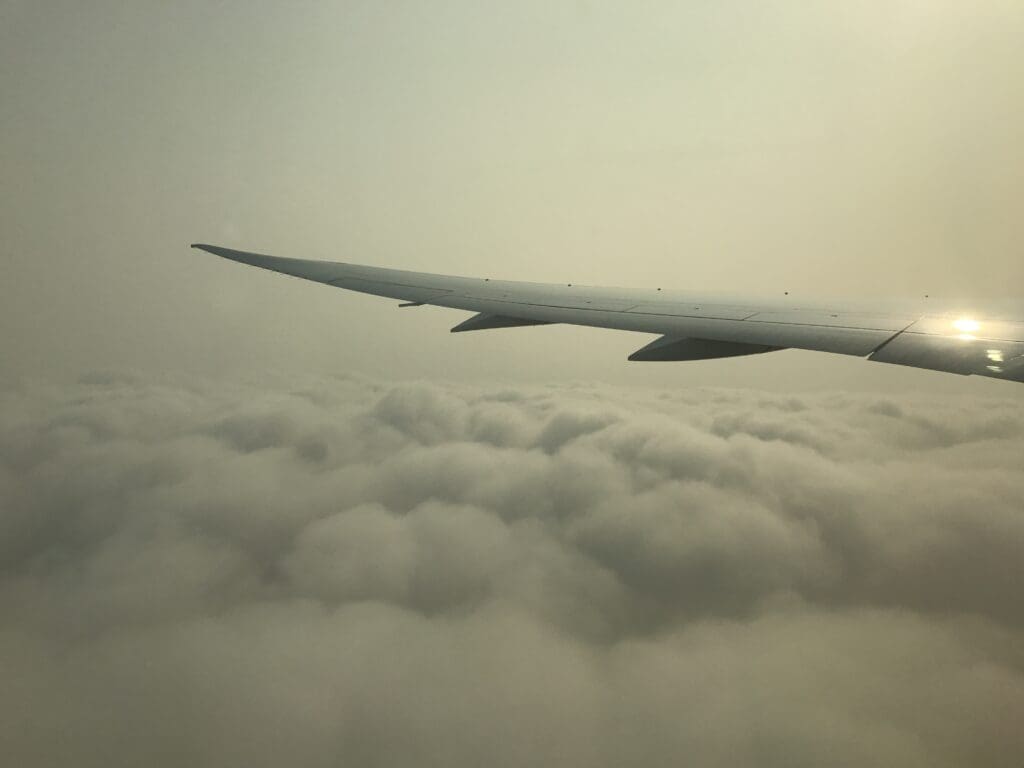
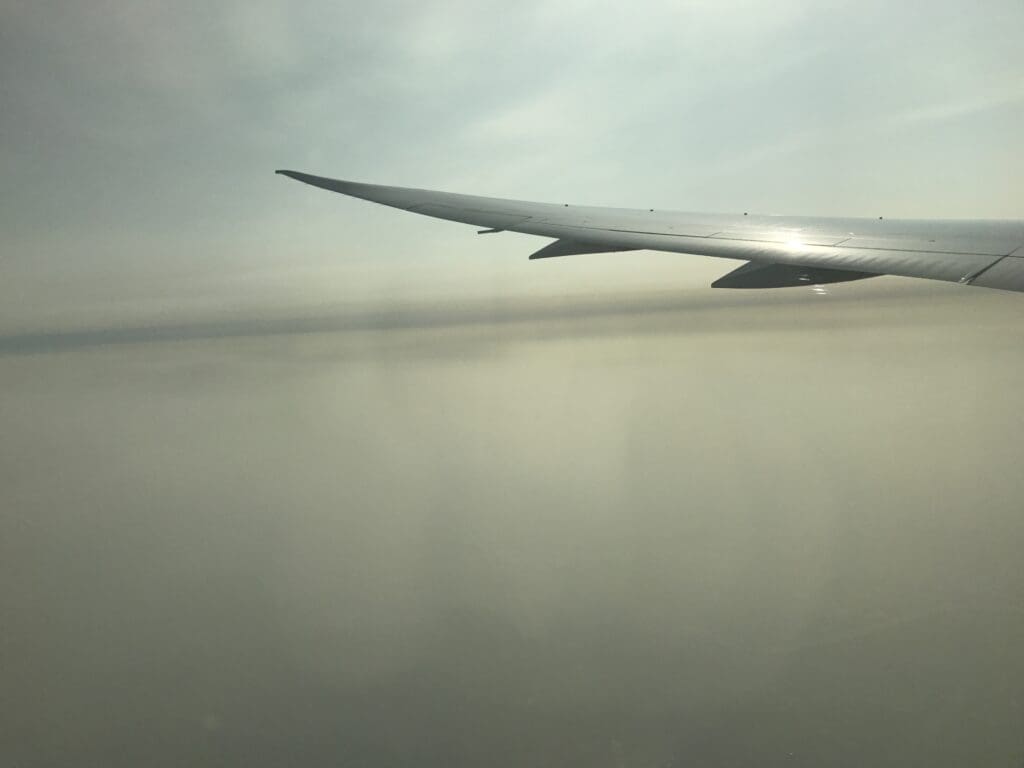
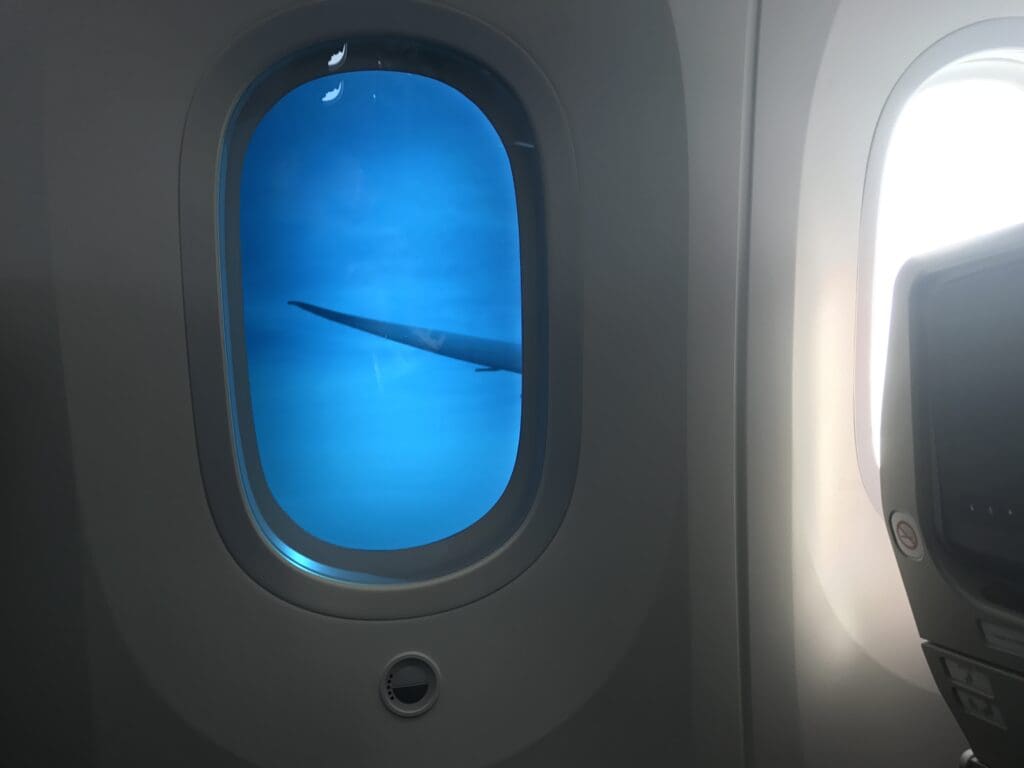
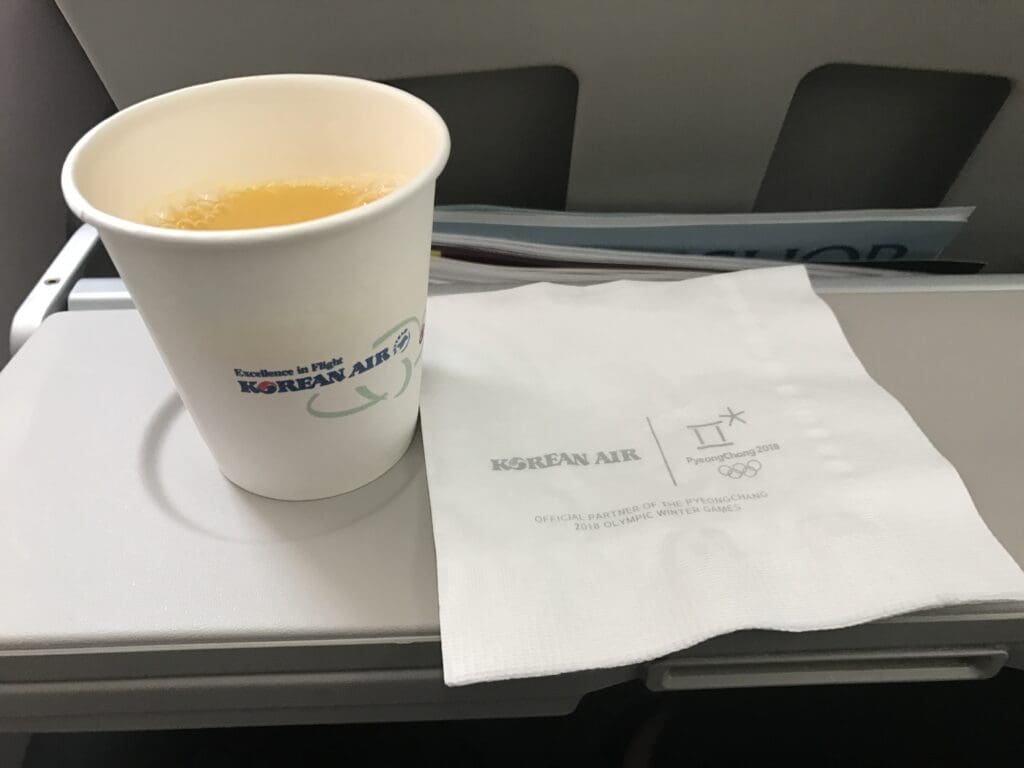
As is the norm on Korean domestic flights, unfortunately, the Beyond inflight entertainment system could not be used, with the inflight entertainment screens being locked on their welcome screen for the duration of the flight. However, our progress could still be tracked as the screens at the front of the cabin displayed the moving map for the duration of the service. Looking outside, unfortunately, with the Korean Peninsula covered by clouds that morning, nothing could be seen of the mountainous landscape below. However, that morning, the Dreamliner took a rather standard route to Jeju. Once away from Seoul, this took us over the historic city of Suwon, before heading onto Hwaseong and flying down the country’s western coastline.
With little to see outside, once I finished my drink I decided to make a quick visit to one of the lavatories at the rear of the aircraft. In total, there are six lavatories available for Economy passengers, four of which sit between the front and rear Economy cabins, with a further two at the rear of the aircraft. This equates to a very reasonable ratio of 41 passengers per lavatory. Entering this without waiting, I found the toilet to be clean, tidy and sufficiently stocked with all the basics, thereby leaving me with absolutely nothing to complain about.
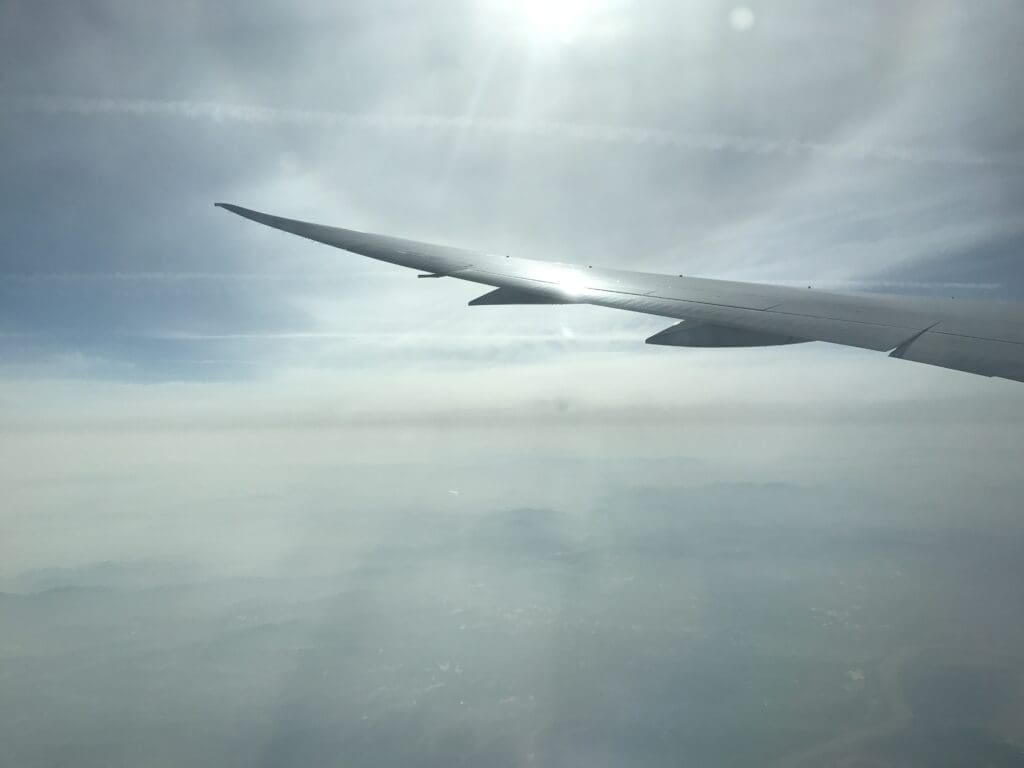
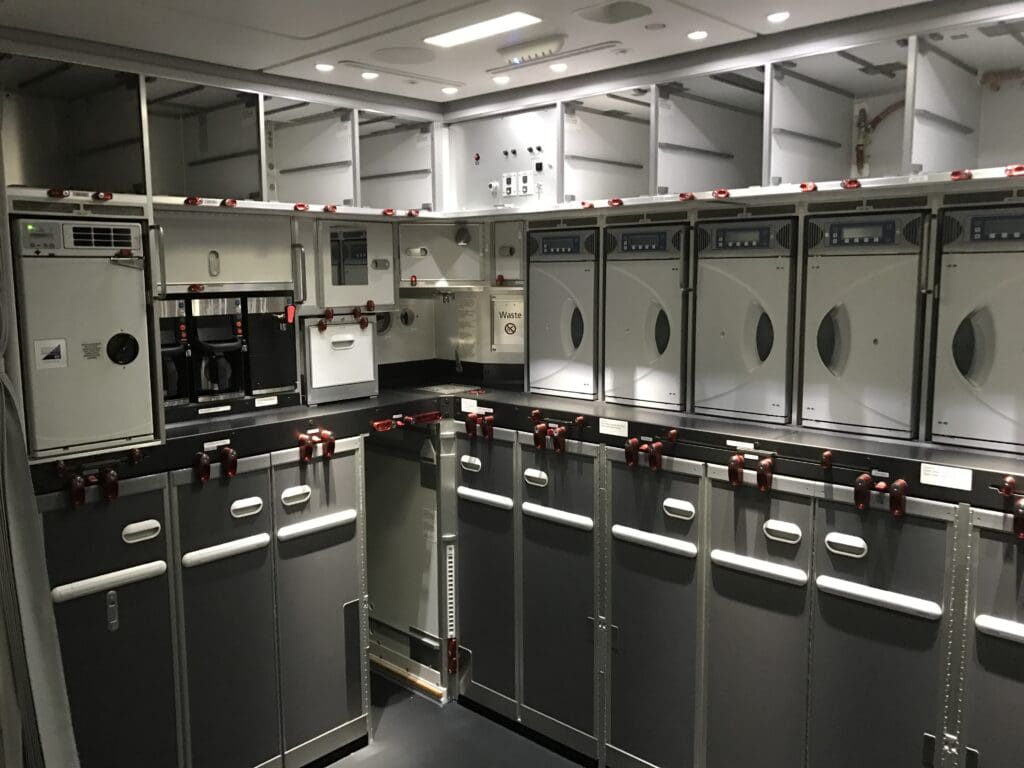
Upon returning to my seat, the aircraft was passing the South Jeolla city of Gwangju and a couple of minutes later the skies cleared a little, allowing for reasonable views of the islands that sit off Korea’s southern coastline. At this point, the North American accented Captain made a brief announcement in English only informing all passengers of the flight’s cruising altitude and speed, and mentioning that this particular flight was the first revenue service of Korean Air’s Boeing 787 Dreamliner. Around thirty minutes into the flight, the aircraft could be felt commencing its descent which was soon confirmed by the reillumination of the seatbelt signs. At this point the crew passed through the cabin collecting all the rubbish from the drinks service and checking that all was secure for the aircraft’s arrival before making an announcement with the usual pre-arrival instructions.
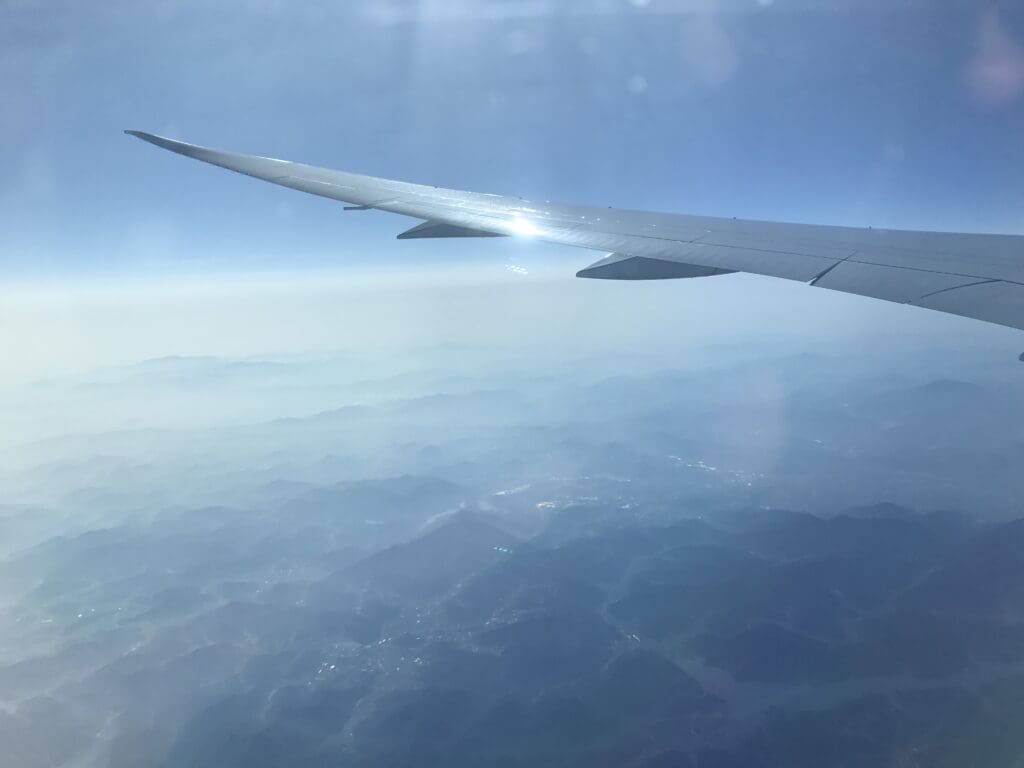
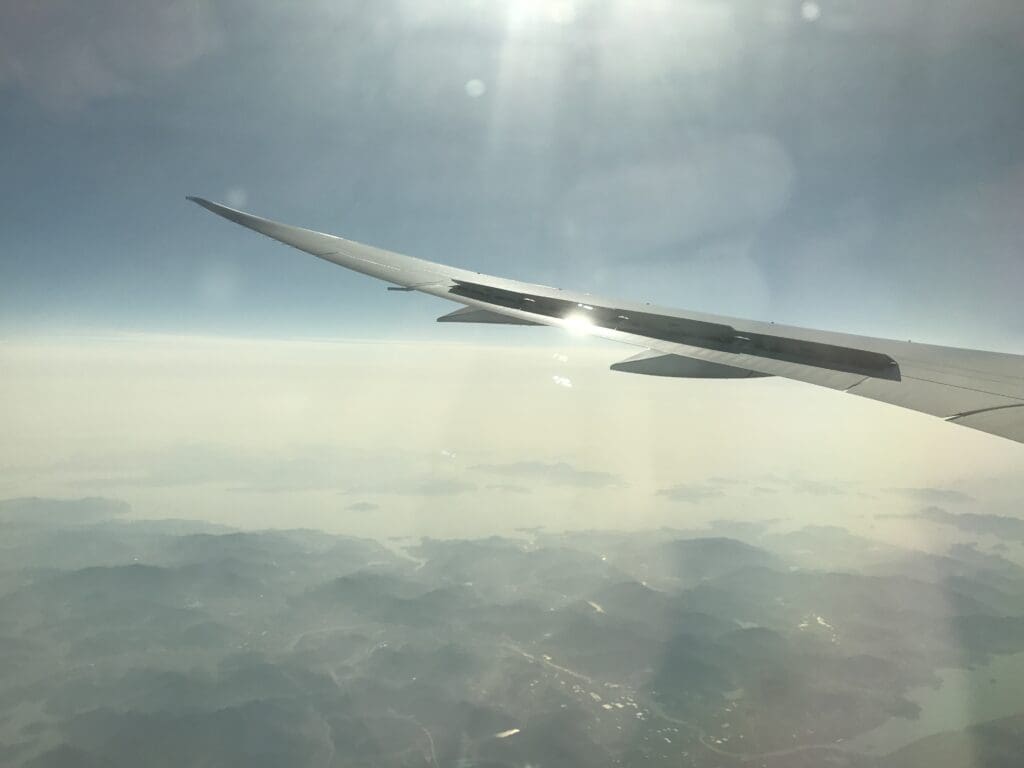
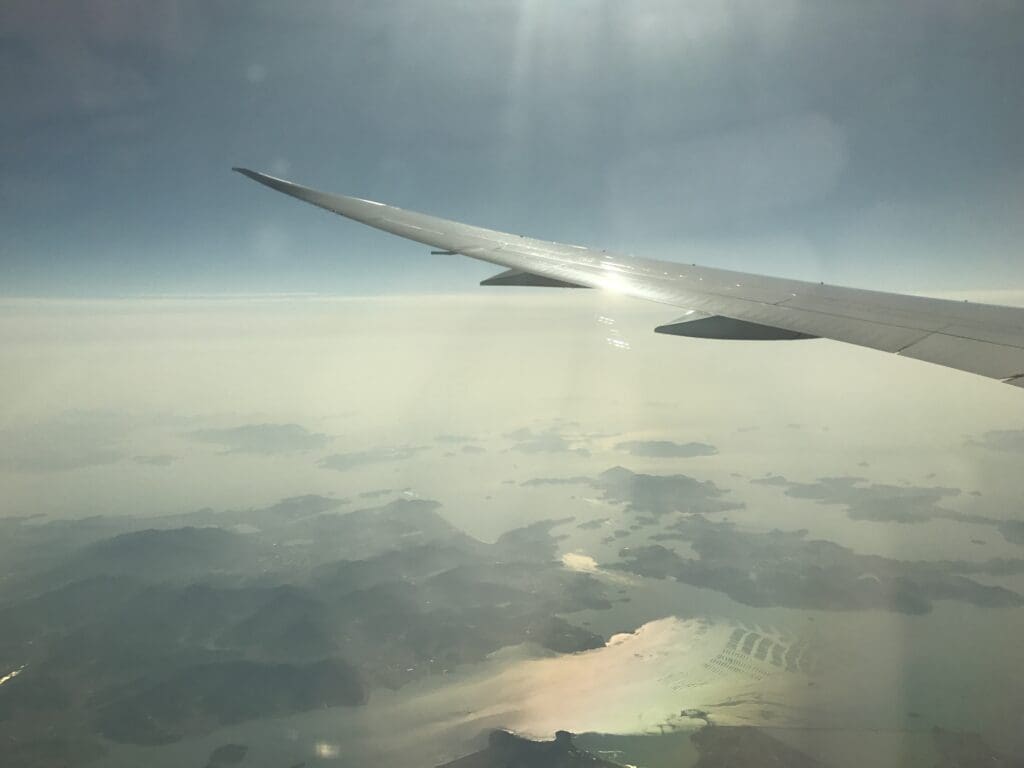
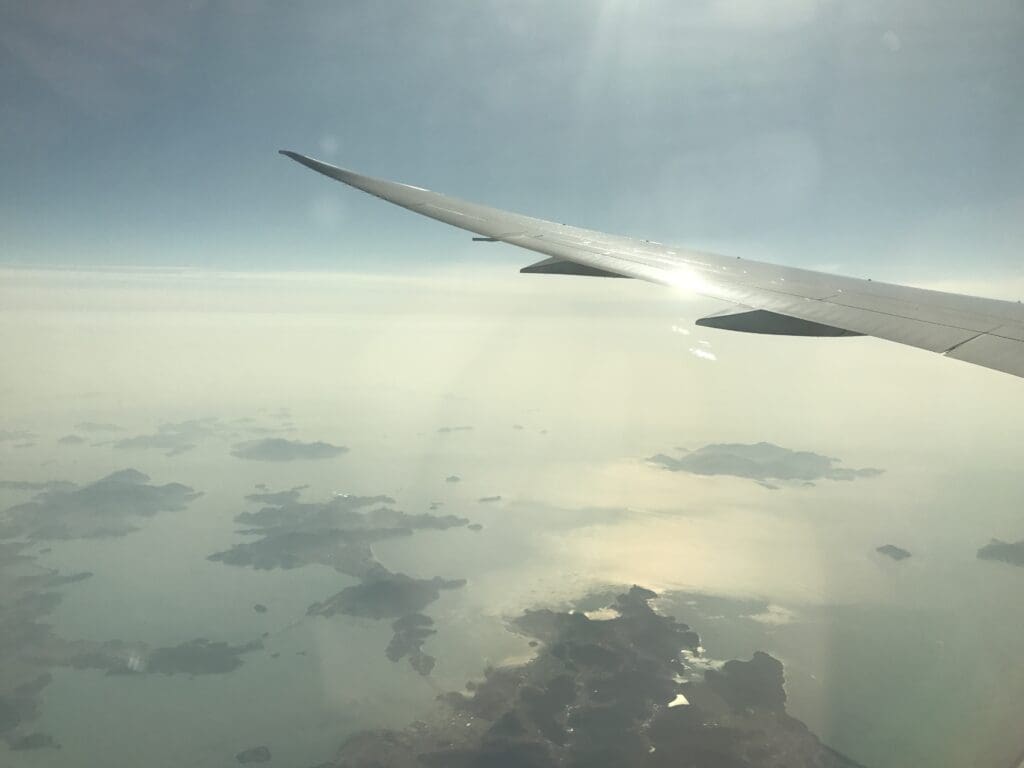
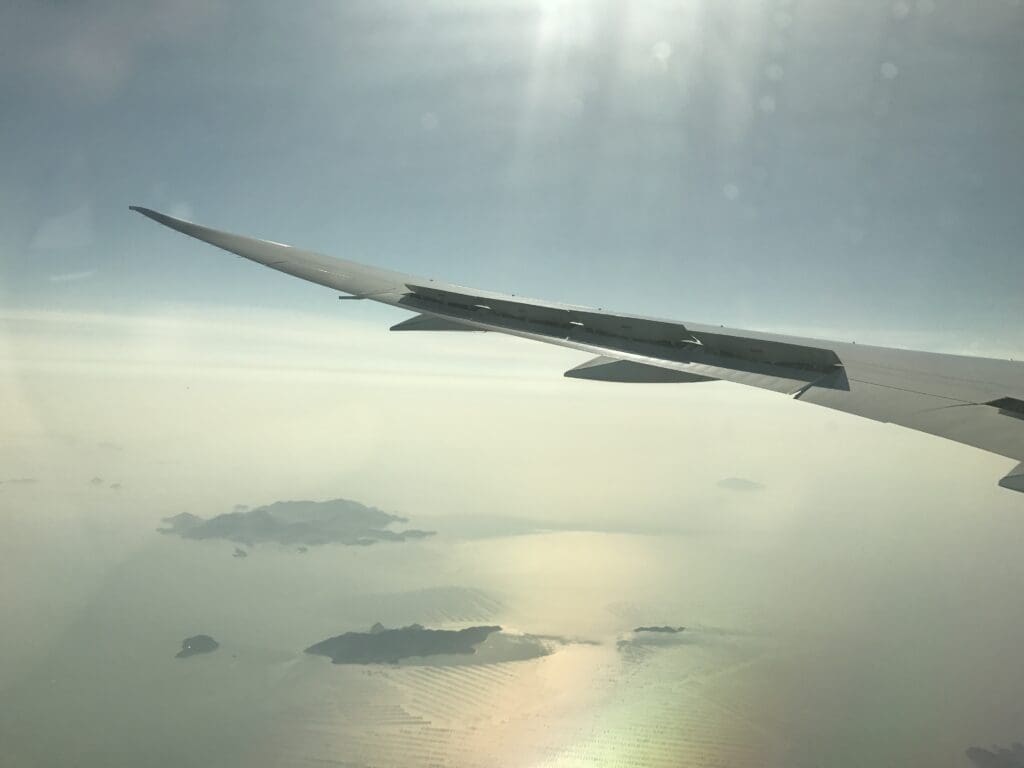
As the Dreamliner descended over the short stretch of water that separates South Jeolla from Jeju, I soon caught sight of the majestic peak of Mount Halla, poking through the morning mist. Meanwhile, looking up above, a fairly constant stream of aircraft could be seen cruising along, almost all of which were heading to and from Korea’s main international hub, Seoul Incheon Airport. Seated on the left hand side of the aircraft, I had hoped for an approach to Runway 25 which would allow for a good view of Jeju’s northeastern shoreline and Jeju City as we neared the airport. However, instead, Runway 07 was in operation which meant that I was sitting on the wrong side of the aircraft for any decent views of Jeju for much of the approach.
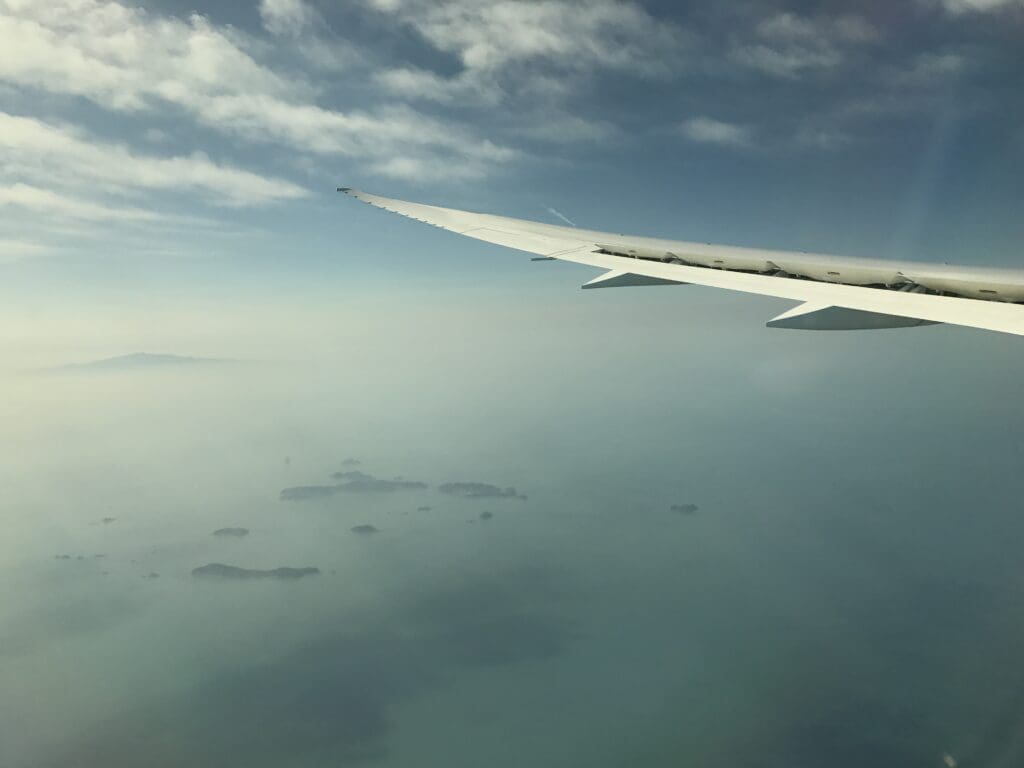
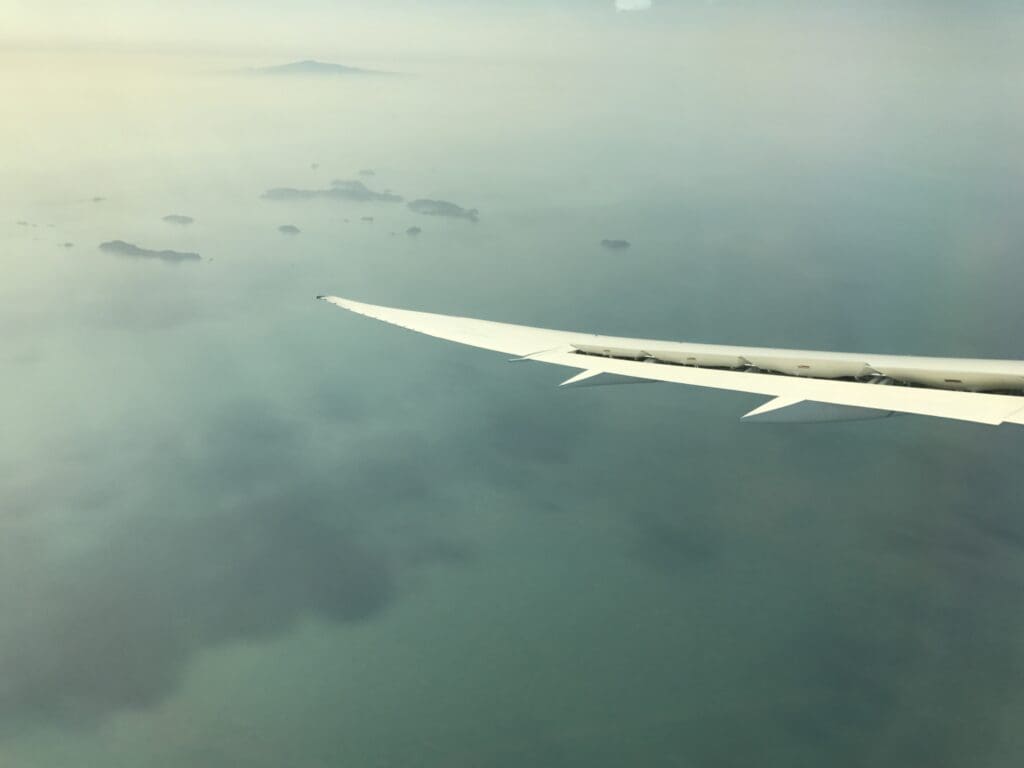
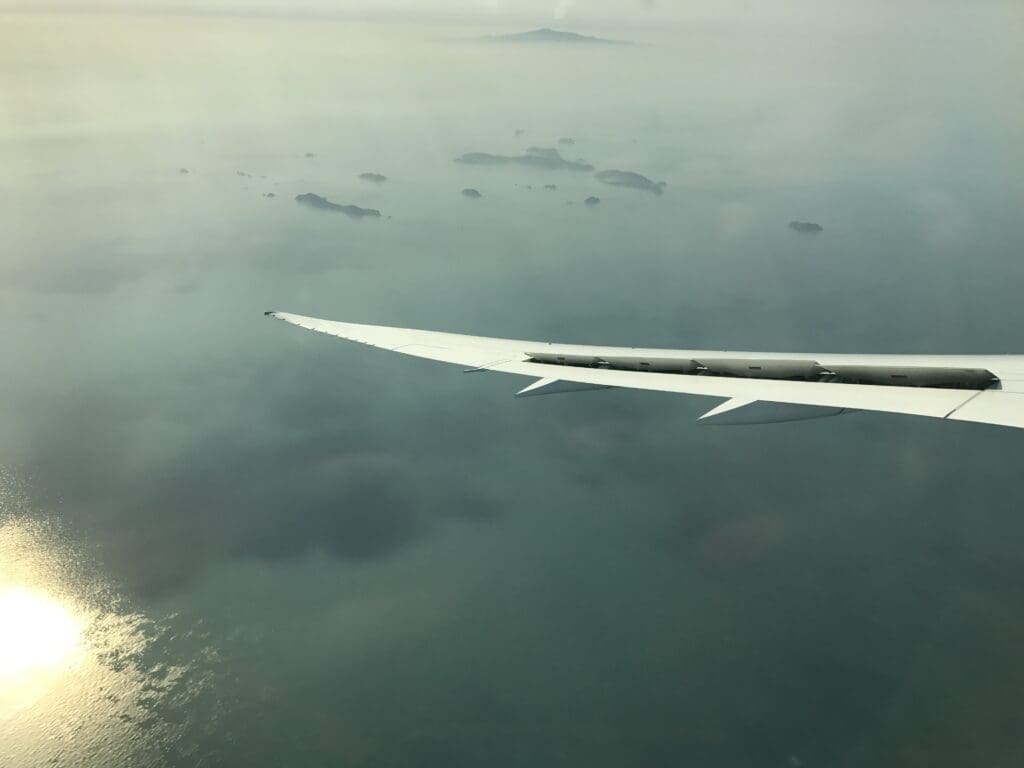
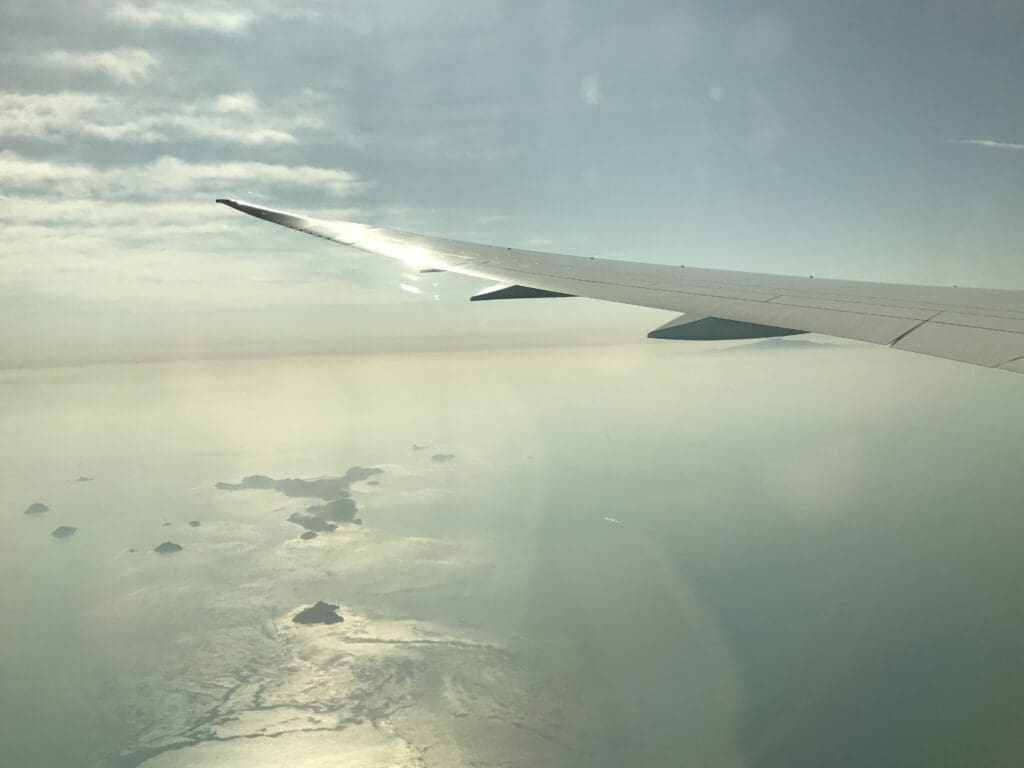
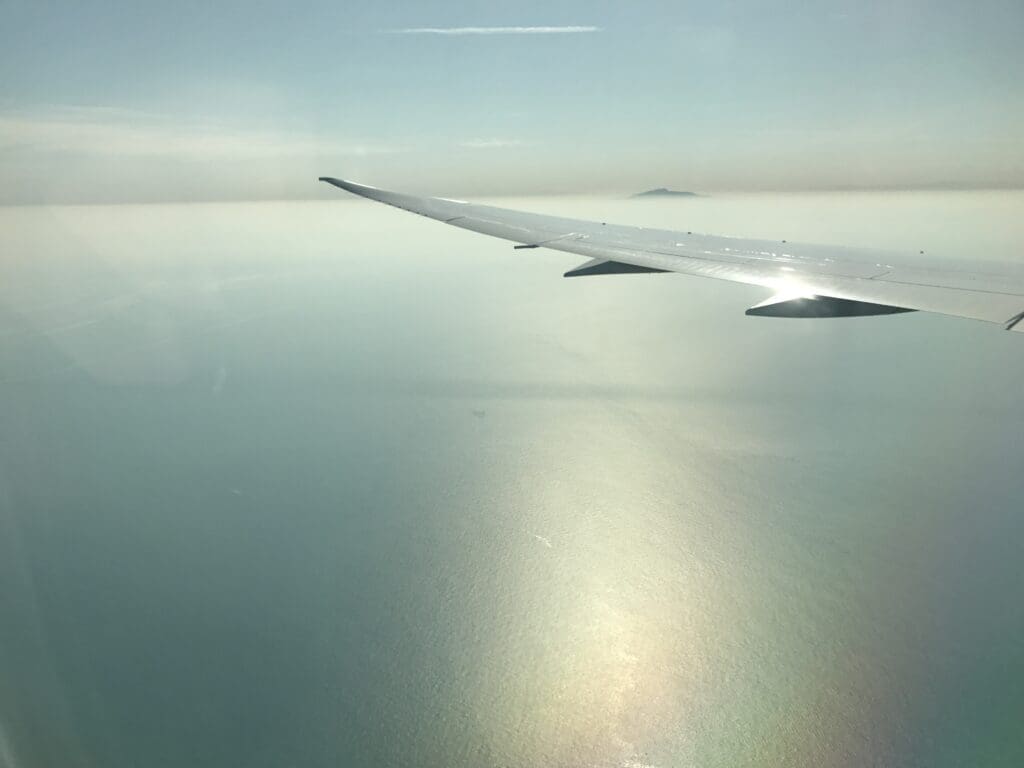
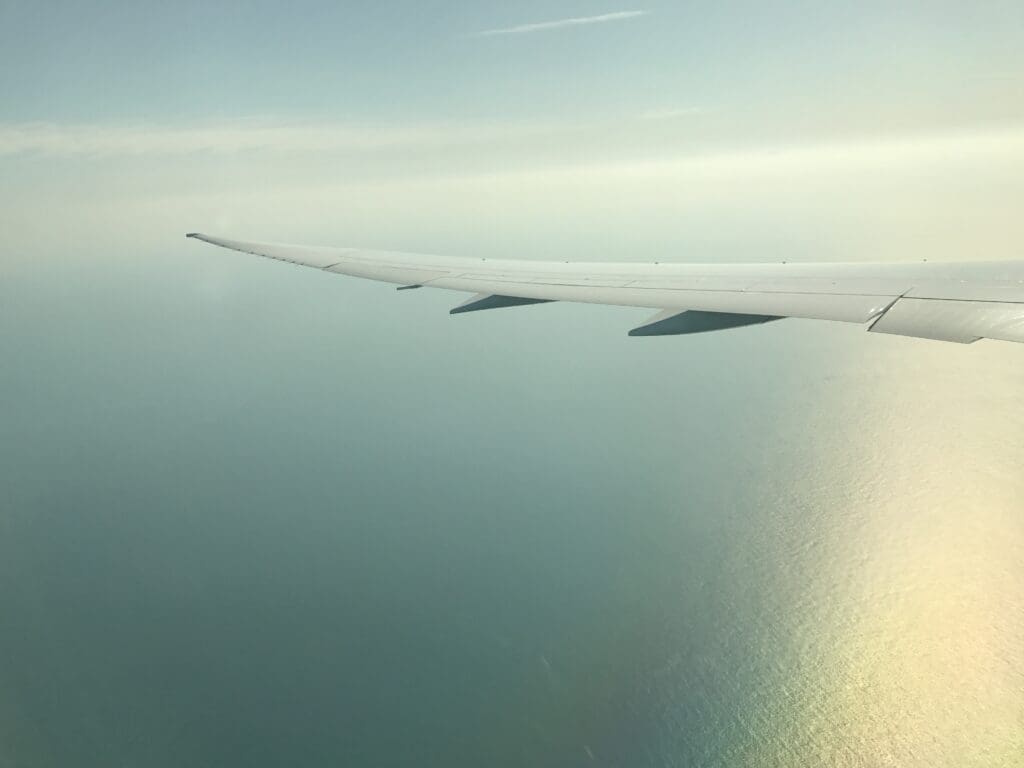
Following our short sprint from the mainland, the Dreamliner floated over the Jejuan coastline near the town of Aewol, and soon the beaches, towns, villages and fields of northwest Jeju appeared below as our flaps were lowered in preparation for our arrival, soon followed by the aircraft’s landing gear which fell into position with an audible clunk.
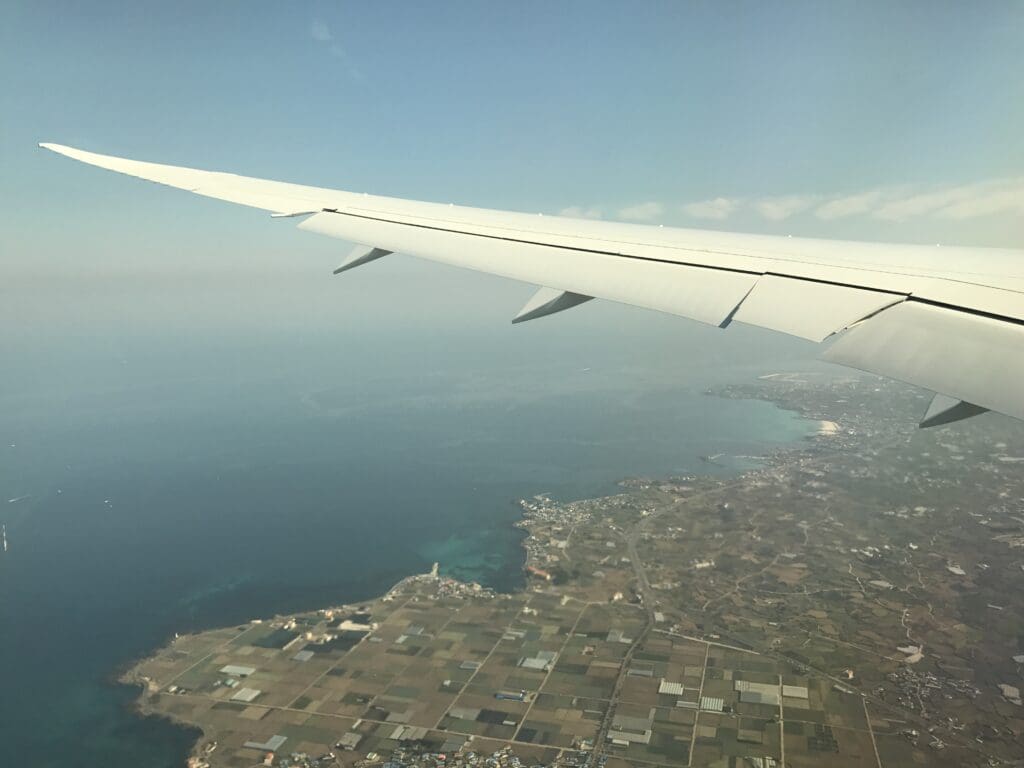
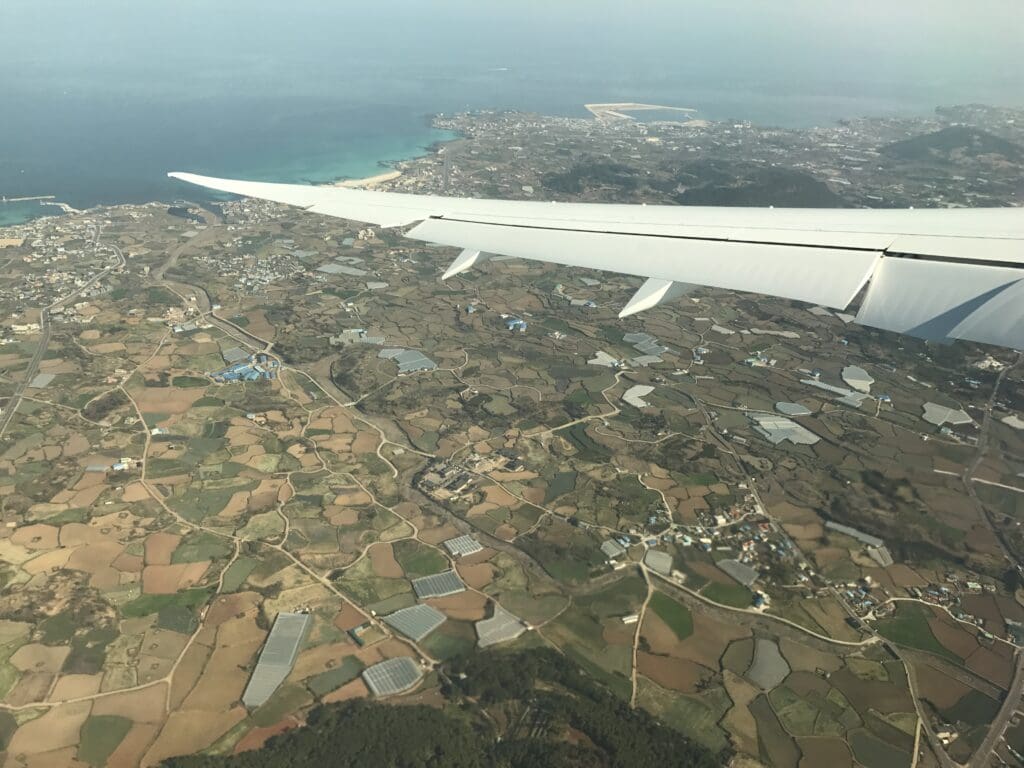
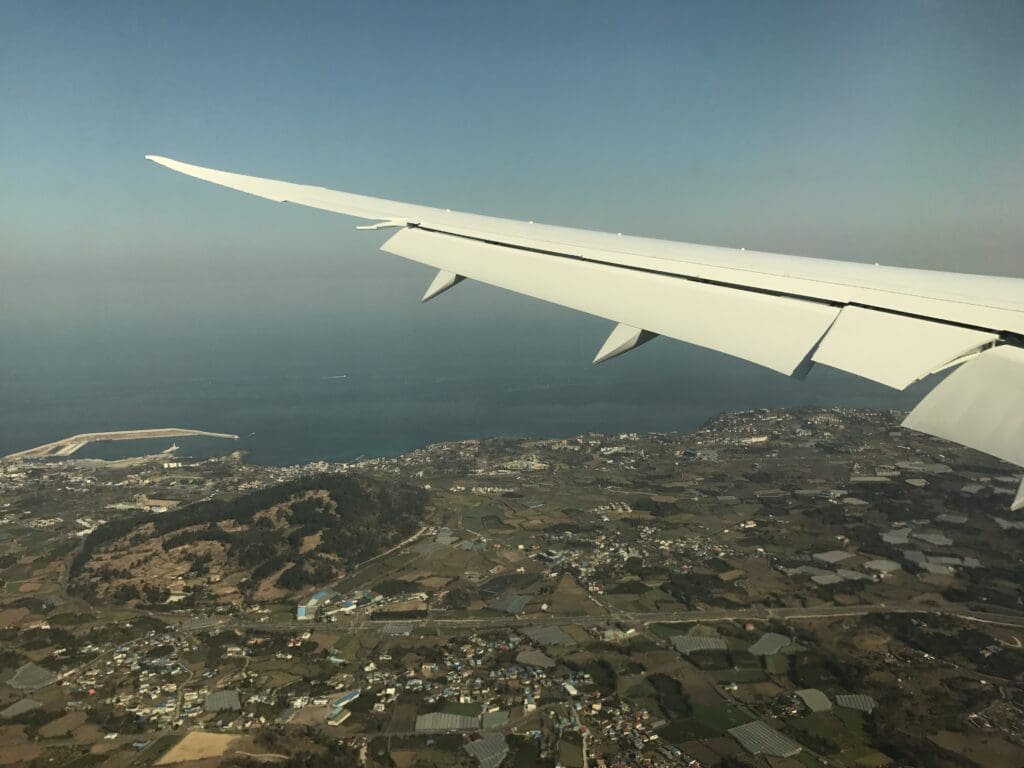
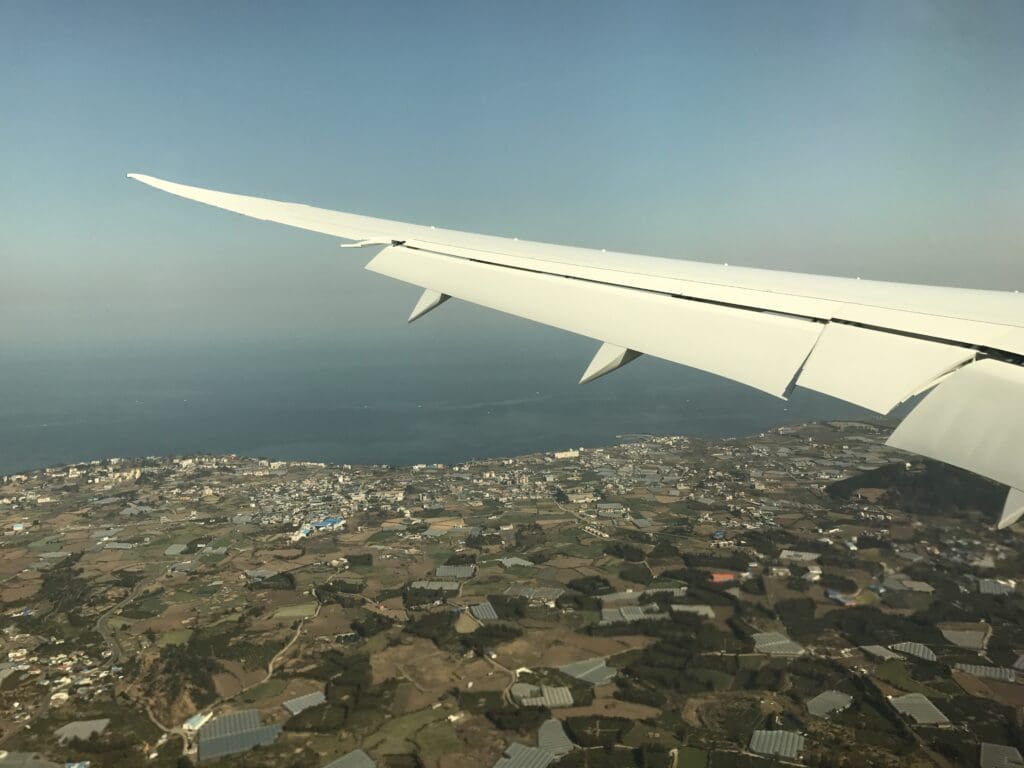
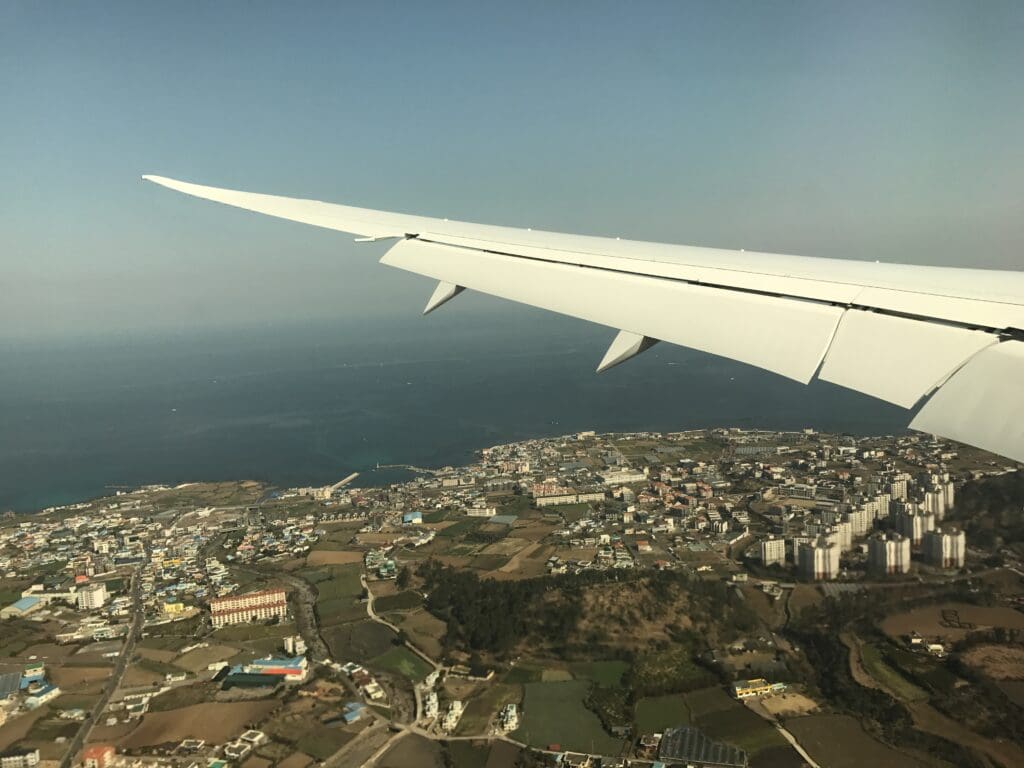
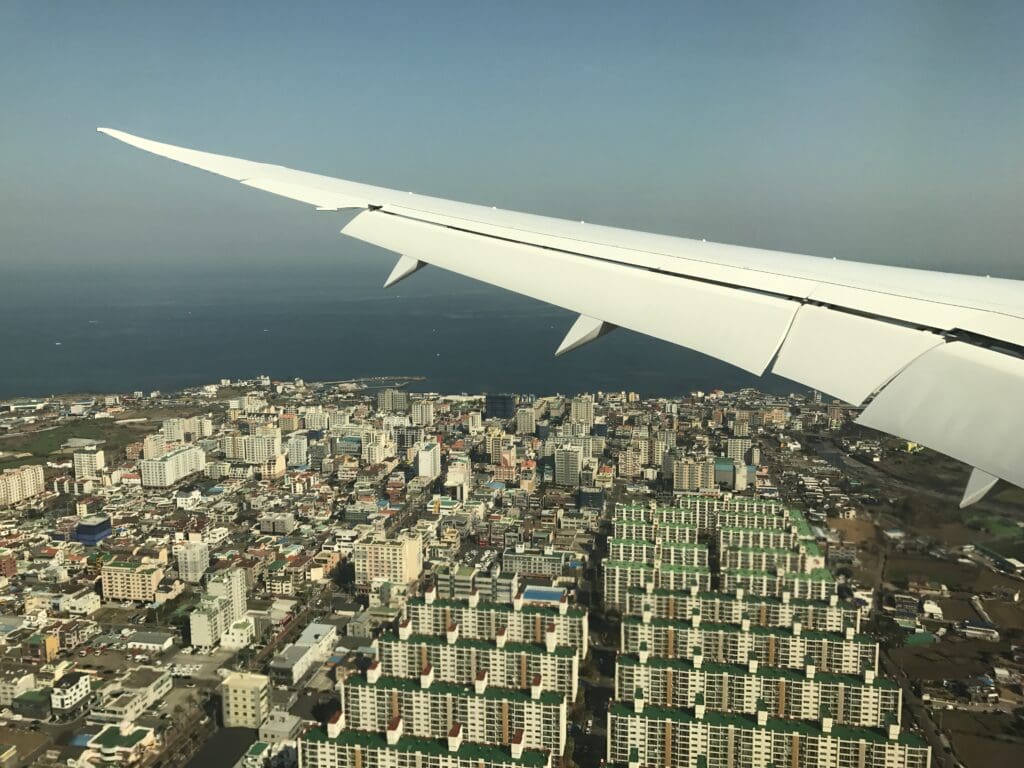
Following our gentle approach, the Red Horse Lighthouse and the coastal village of Dodu appeared as we sank over Jeju International Airport’s fence and past the perimeter watchtowers before making a smooth touchdown on Runway 07 at 1019, ending our 58-minute journey through the Korean skies. Once safely on the island, the Dreamliner braked rather heavily, and we soon vacated the runway to the right, making what seemed to be a slow and cautious taxi over to Stand 13 at the terminal. Just like the rest of the service, whilst this was the first visit of a Boeing 787 to Jeju, there seemed to be little fanfare on the ground and there was most certainly no water cannon salute provided. In the usual manner, as we made our way over to the gate, the Purser performed an announcement in Korean and English, welcoming all passengers to Jeju and thanking passengers for flying with Korean Air.
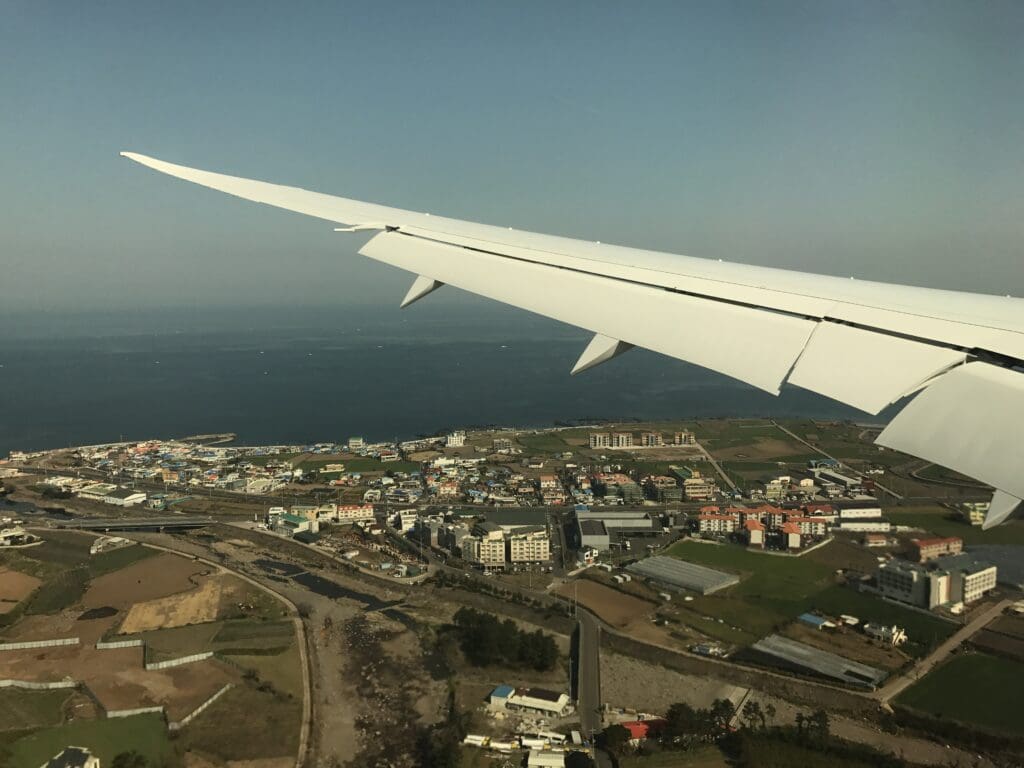
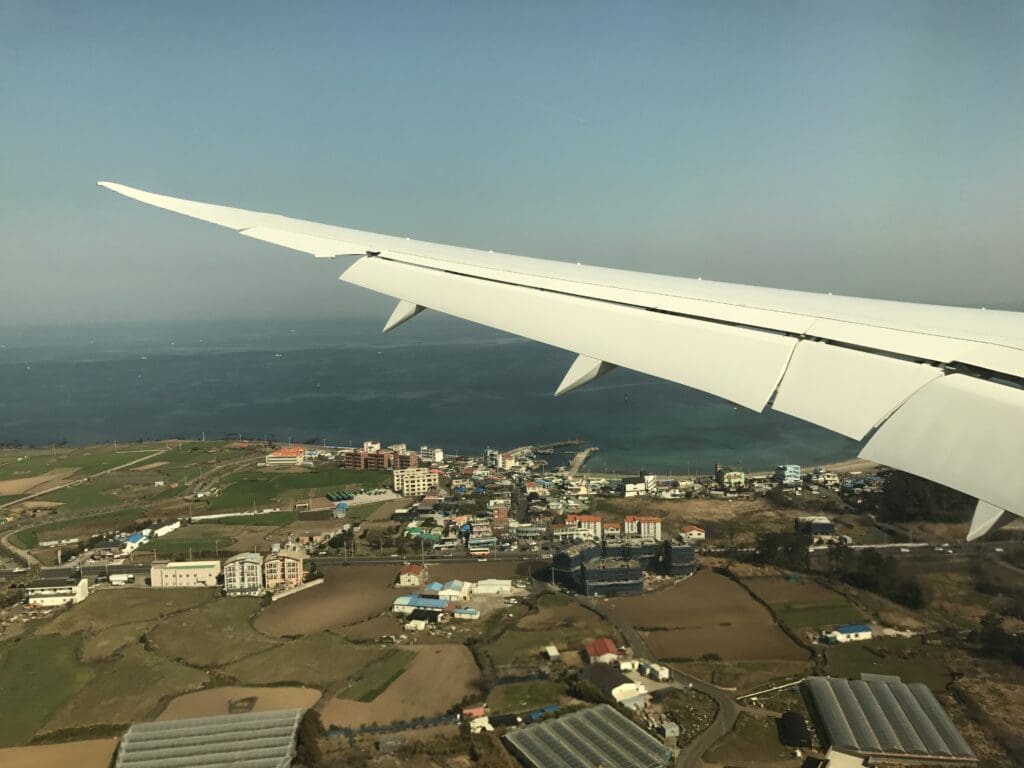
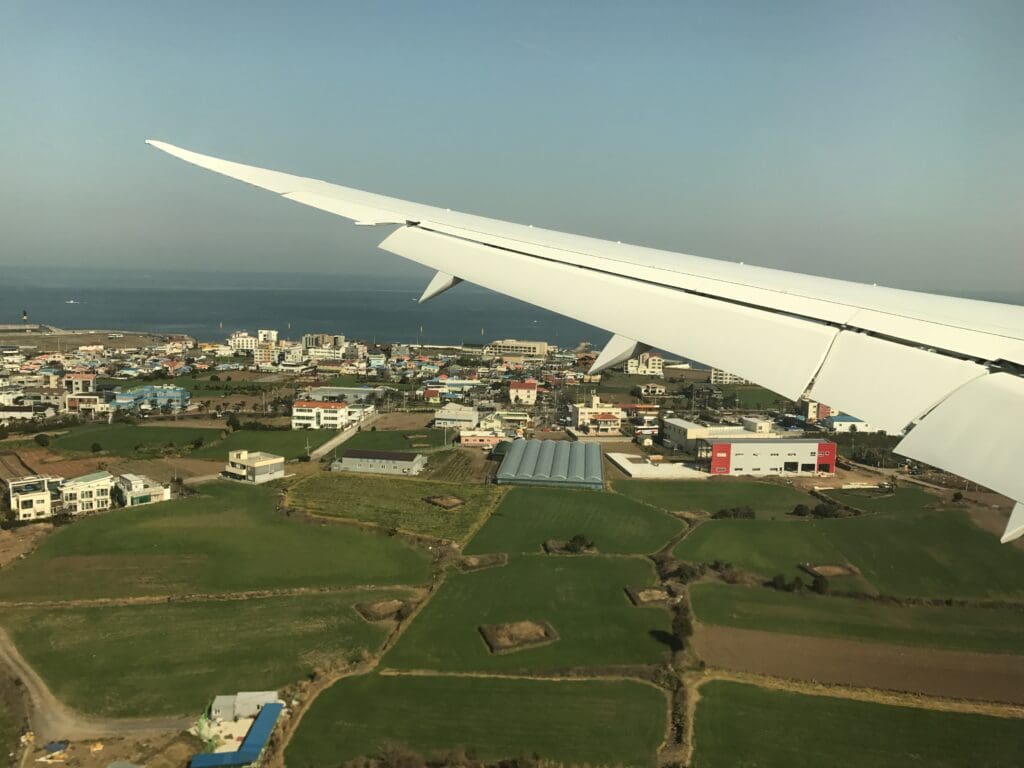
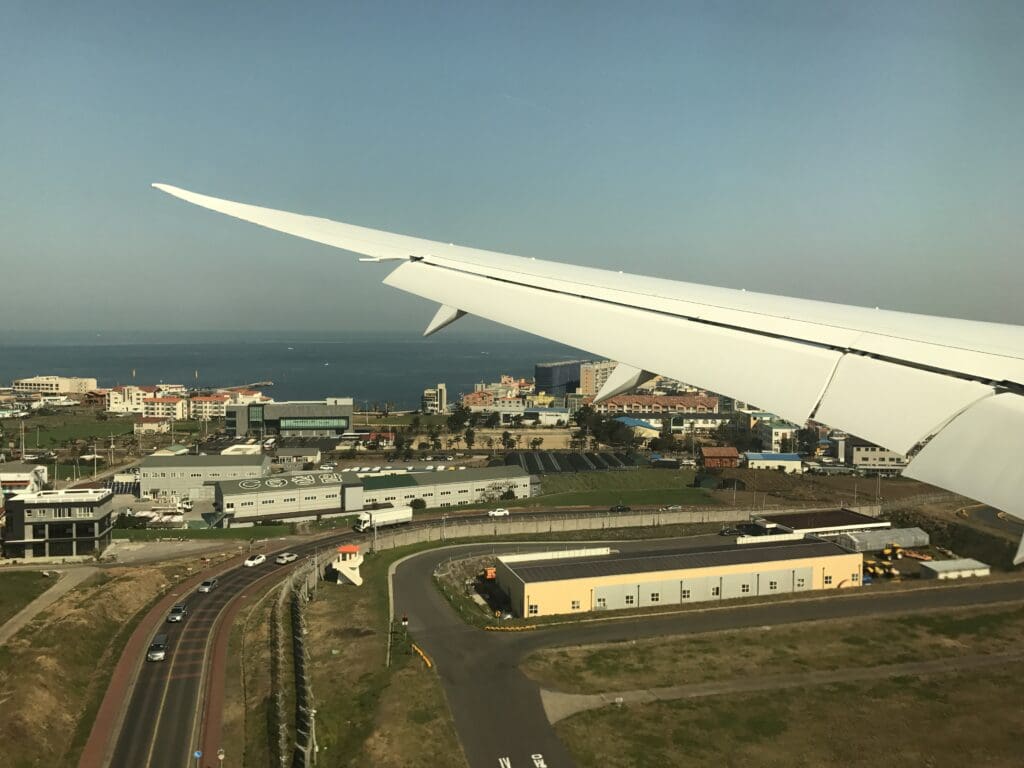
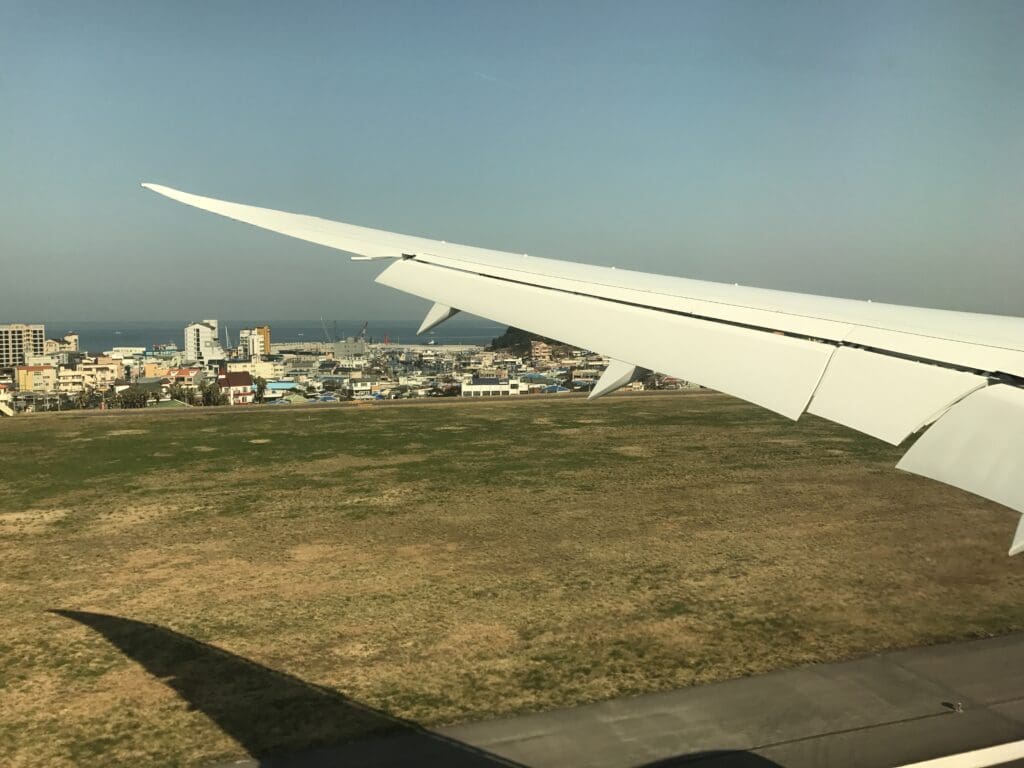
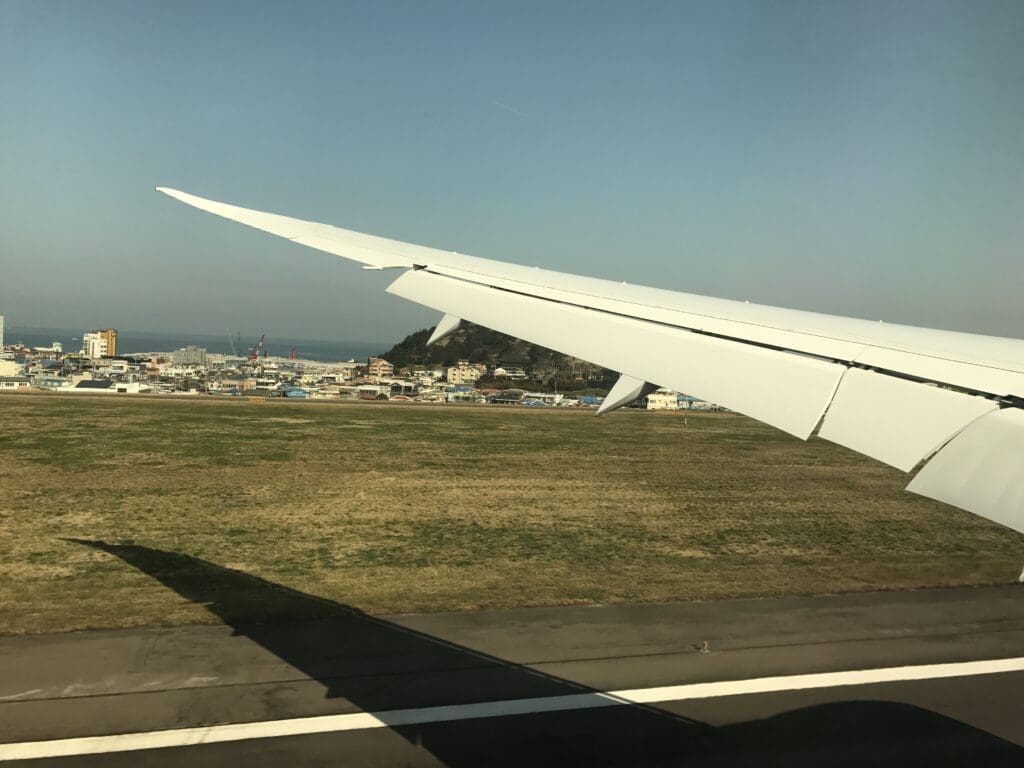
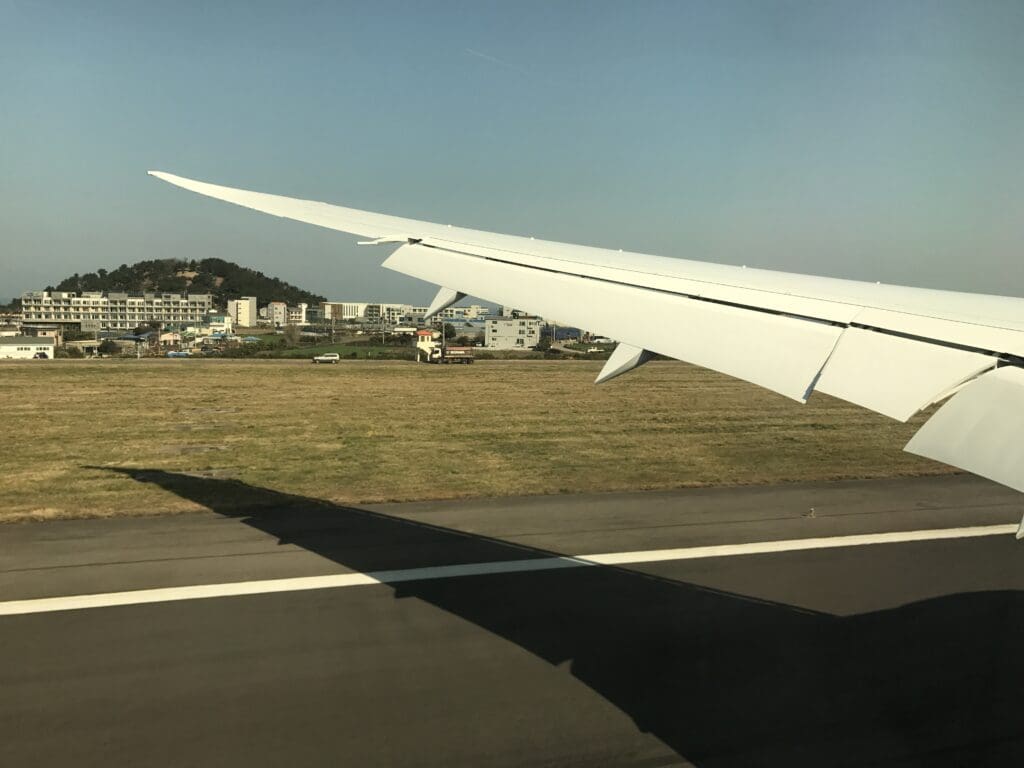
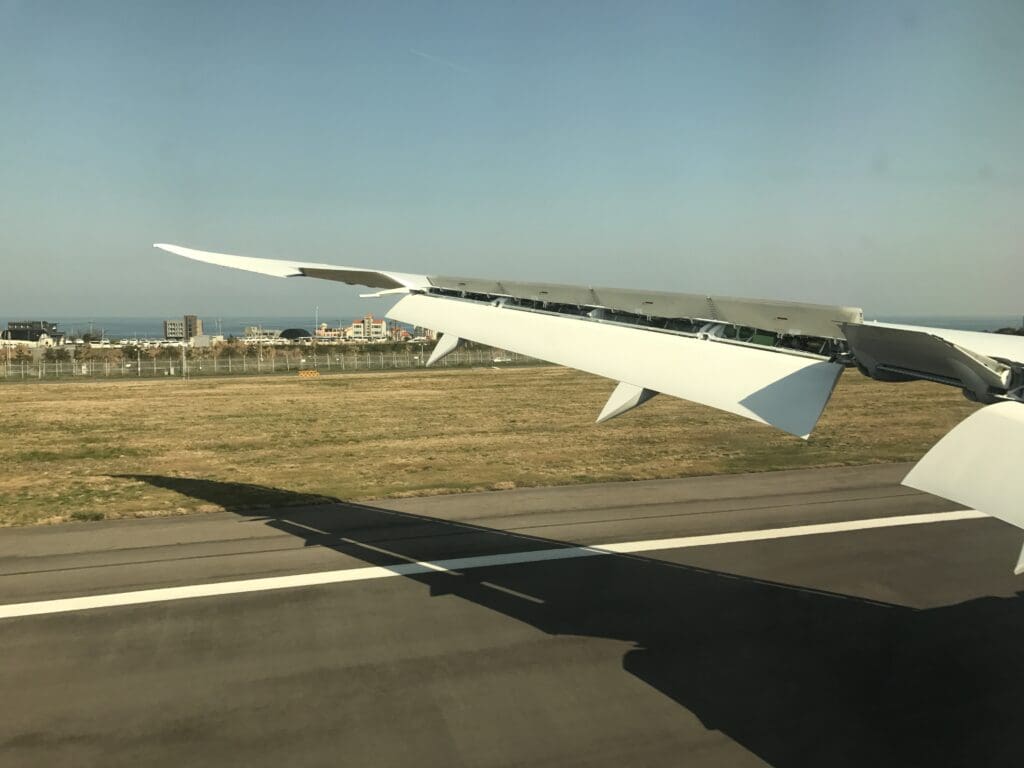
A few minutes after touching down, the Dreamliner slowly pulled into the gate, slotting itself between a Jin Air Boeing 737-800 that had departed Seoul Gimpo minutes before our flight, and a Spring Airlines Airbus A320 at the neighbouring international gate. Perhaps taking extra care, once the Dreamliner’s massive engines spooled down, it seemed to take a little while for the jetbridge to be connected to the aircraft although most passengers appeared not to be in any hurry to disembark and many remained patiently seated until the L1 door had been opened. Eventually, disembarkation commenced and after slowly making my way down the aircraft, thanking several crew members as I made my way to the front of the cabin and receiving a thank you and farewell from each in return, I stepped off the jet and made my way into the terminal building.
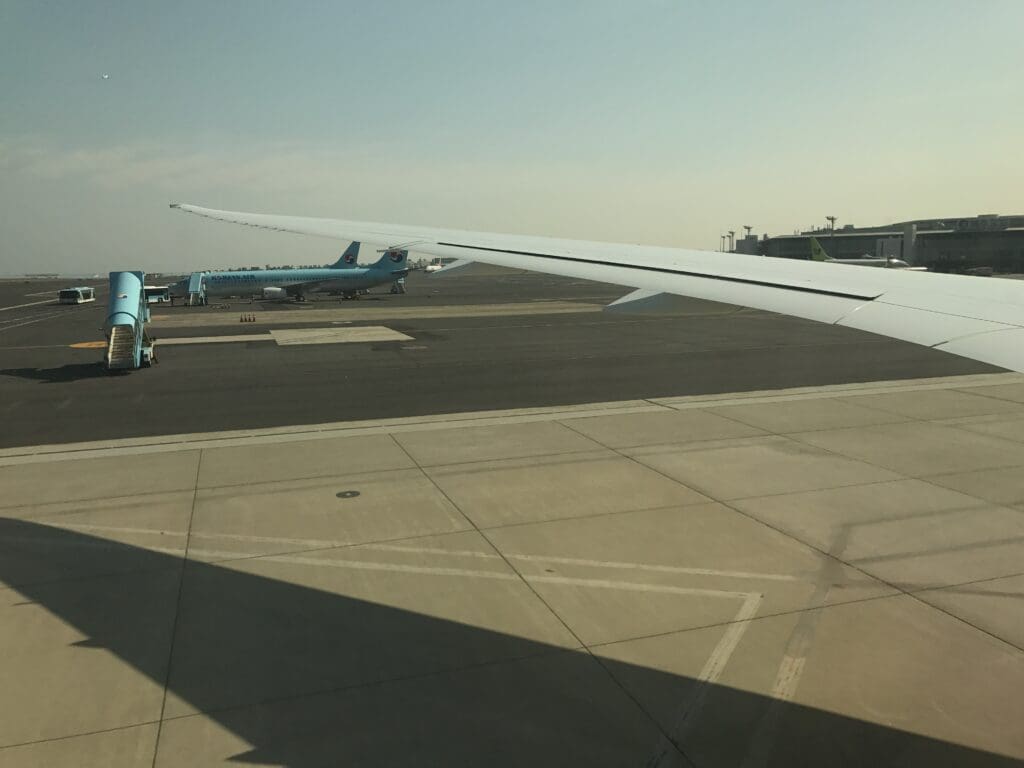
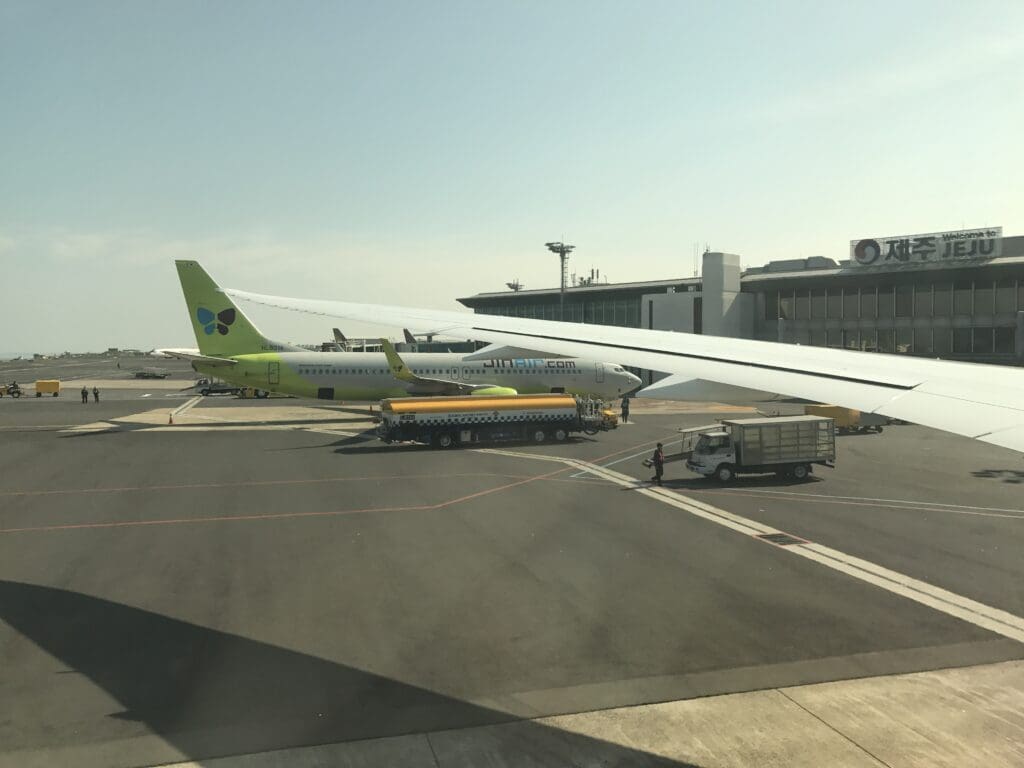

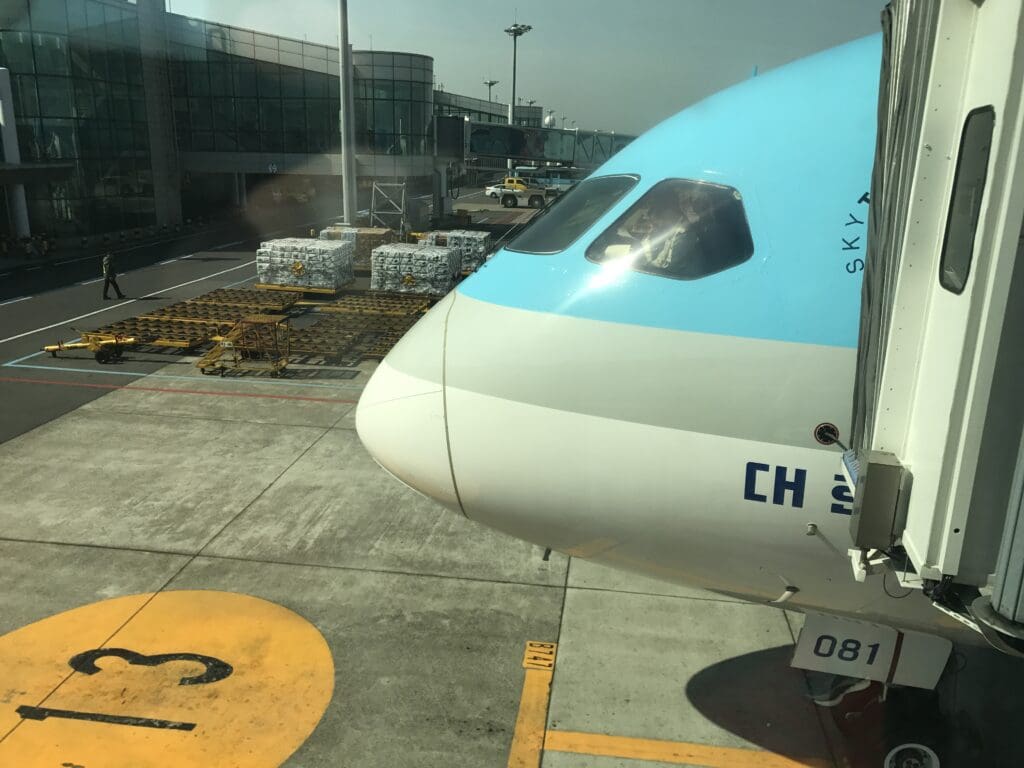
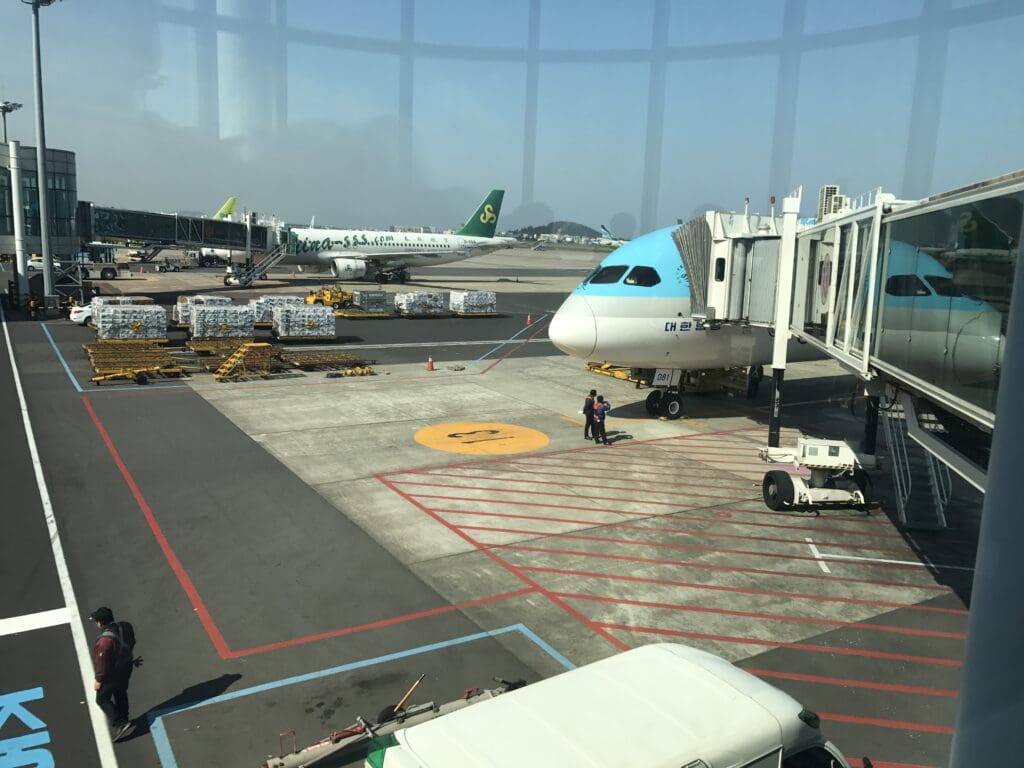
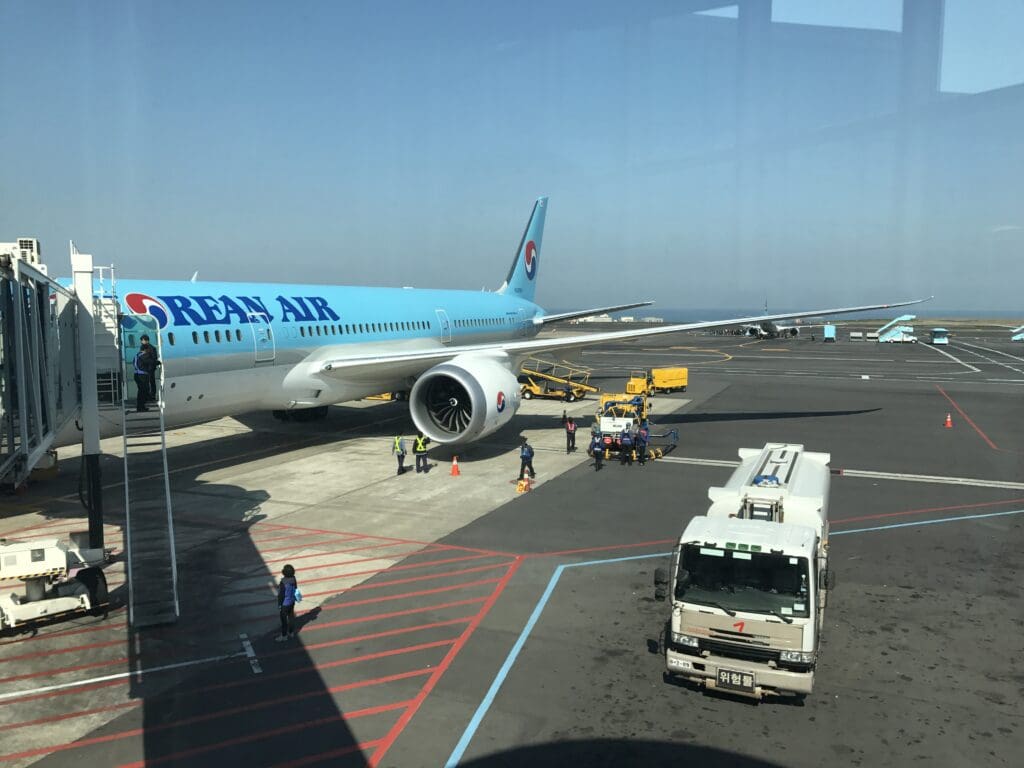
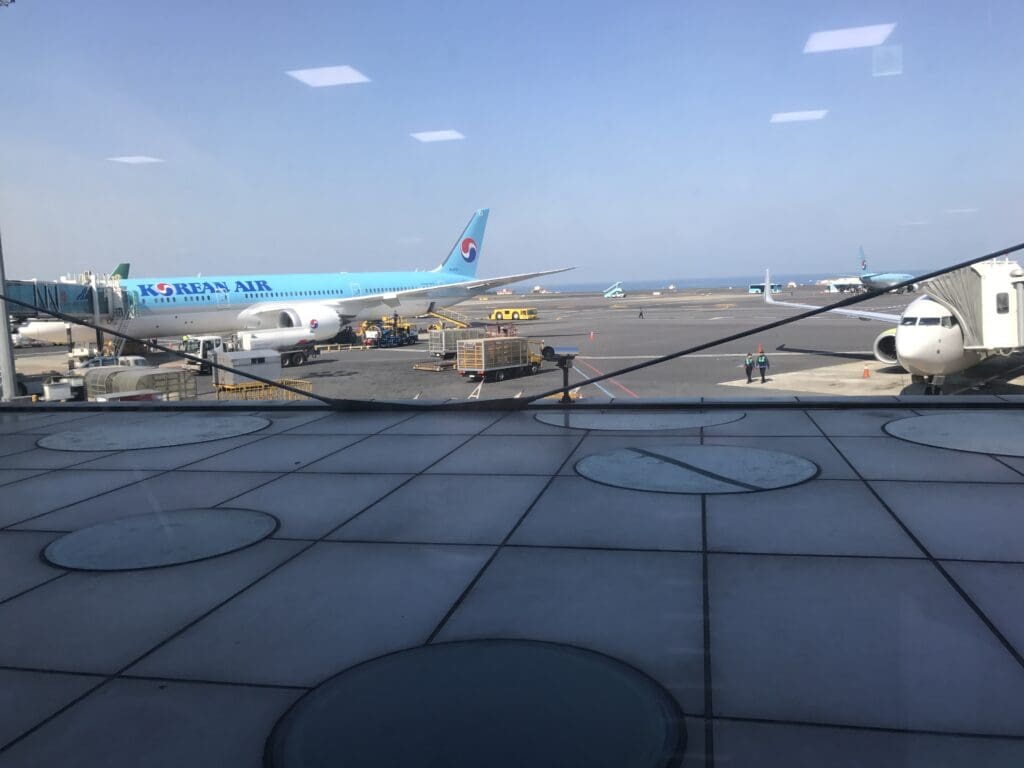
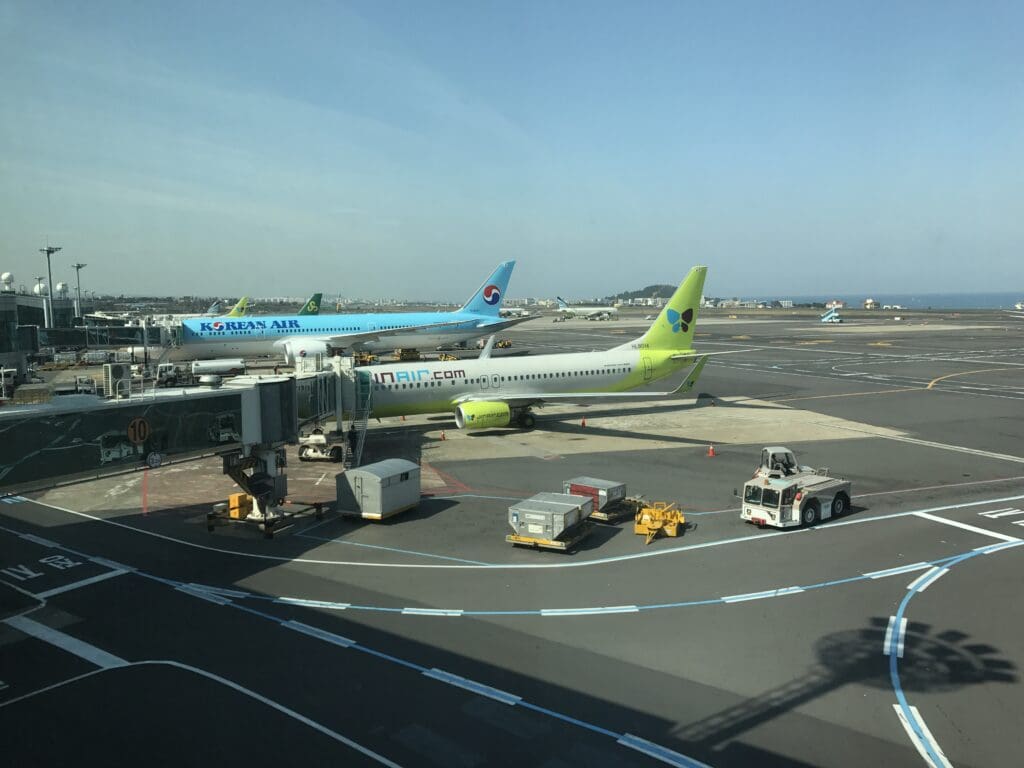
Conclusion
My short flight on Korean Air’s first-ever Boeing 787-9 Dreamliner left me with no complaints. As expected the aircraft was modern and comfortable and I would most definitely not hesitate to fly aboard a Korean Air Boeing 787 on a long haul service across the world. Meanwhile, as I have found to almost always be the case with Korean Air, the flight attendants were polite and friendly and went about their duties in a professional manner.
The biggest surprise was the apparent lack of any celebration despite it being the first revenue flight of a Boeing 787 with any Korean carrier. Were it not for the brief mention of the fact that this was the first commercial flight of Korean Air’s Dreamliner by the Captain or the many aviation enthusiasts onboard, the average passenger may well have not realised that there was anything particularly special about this service.

